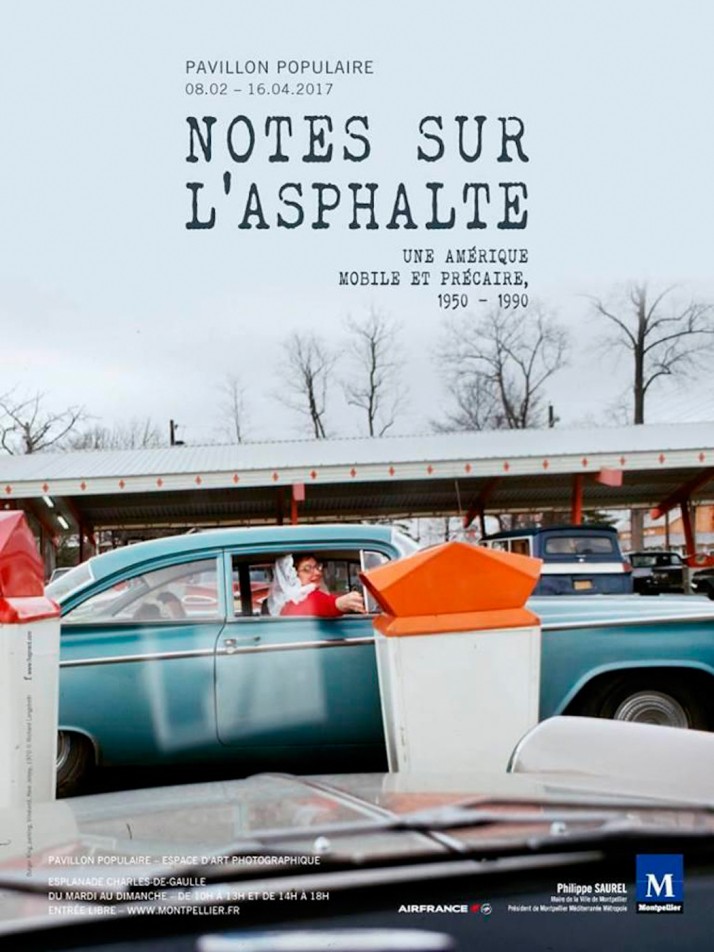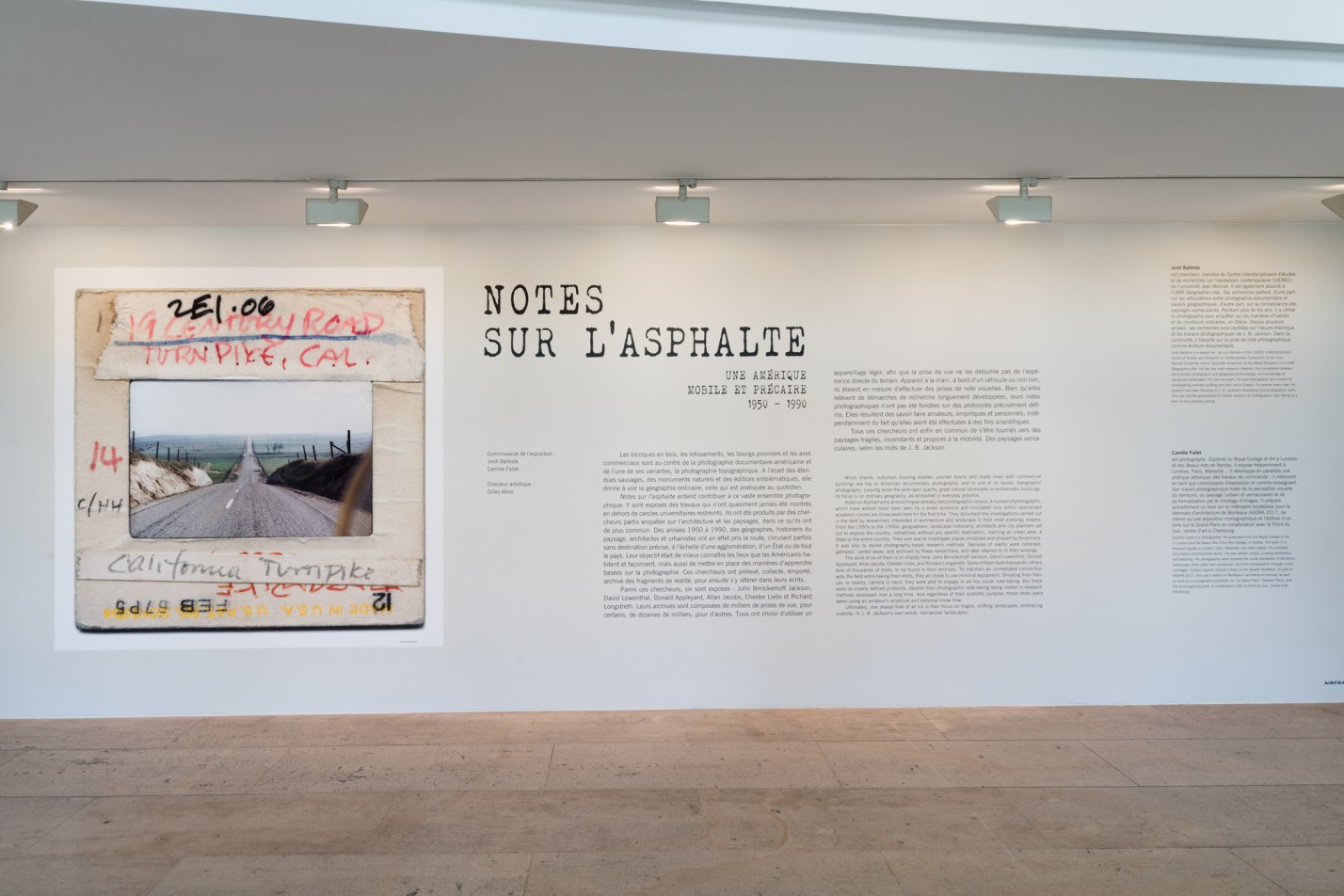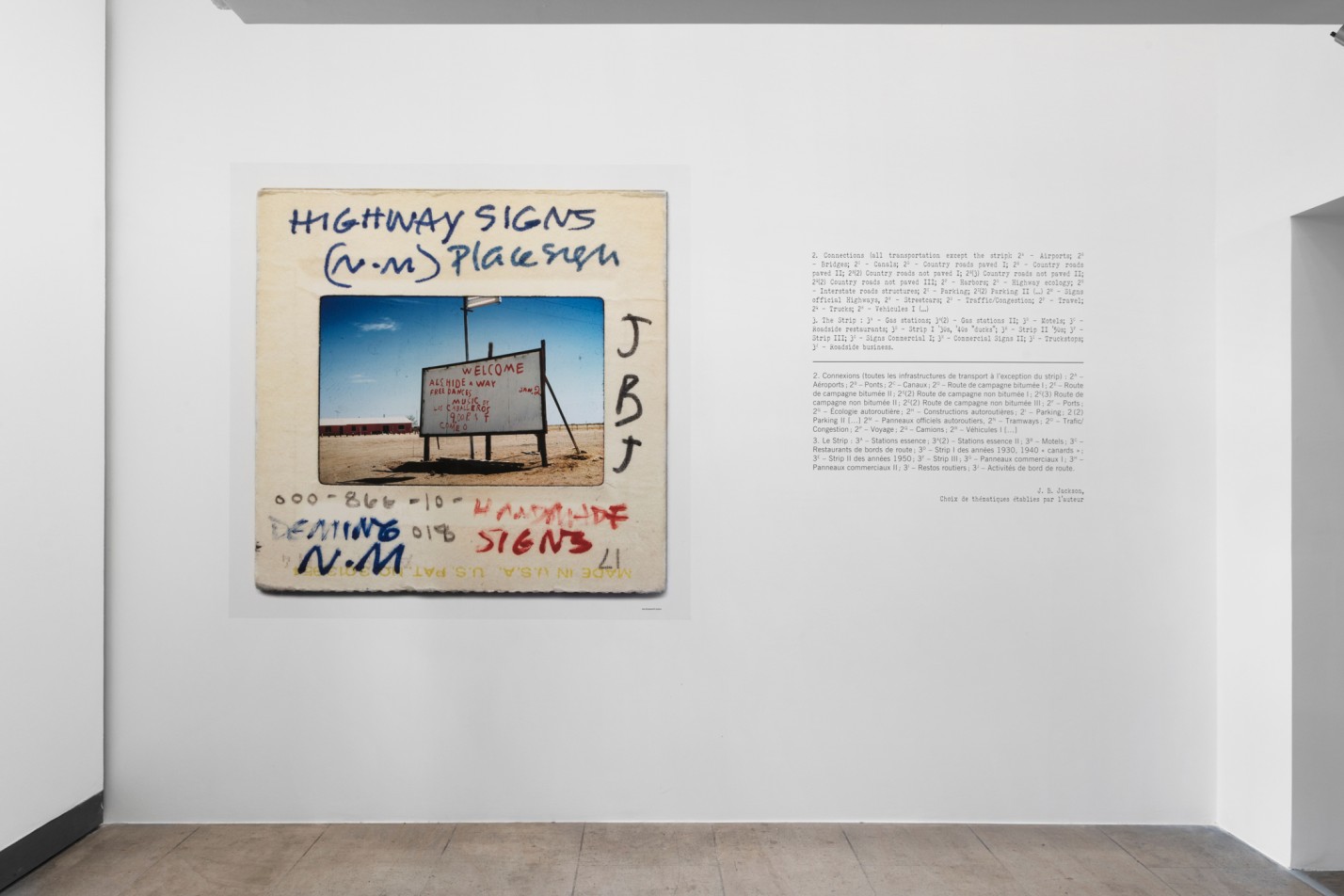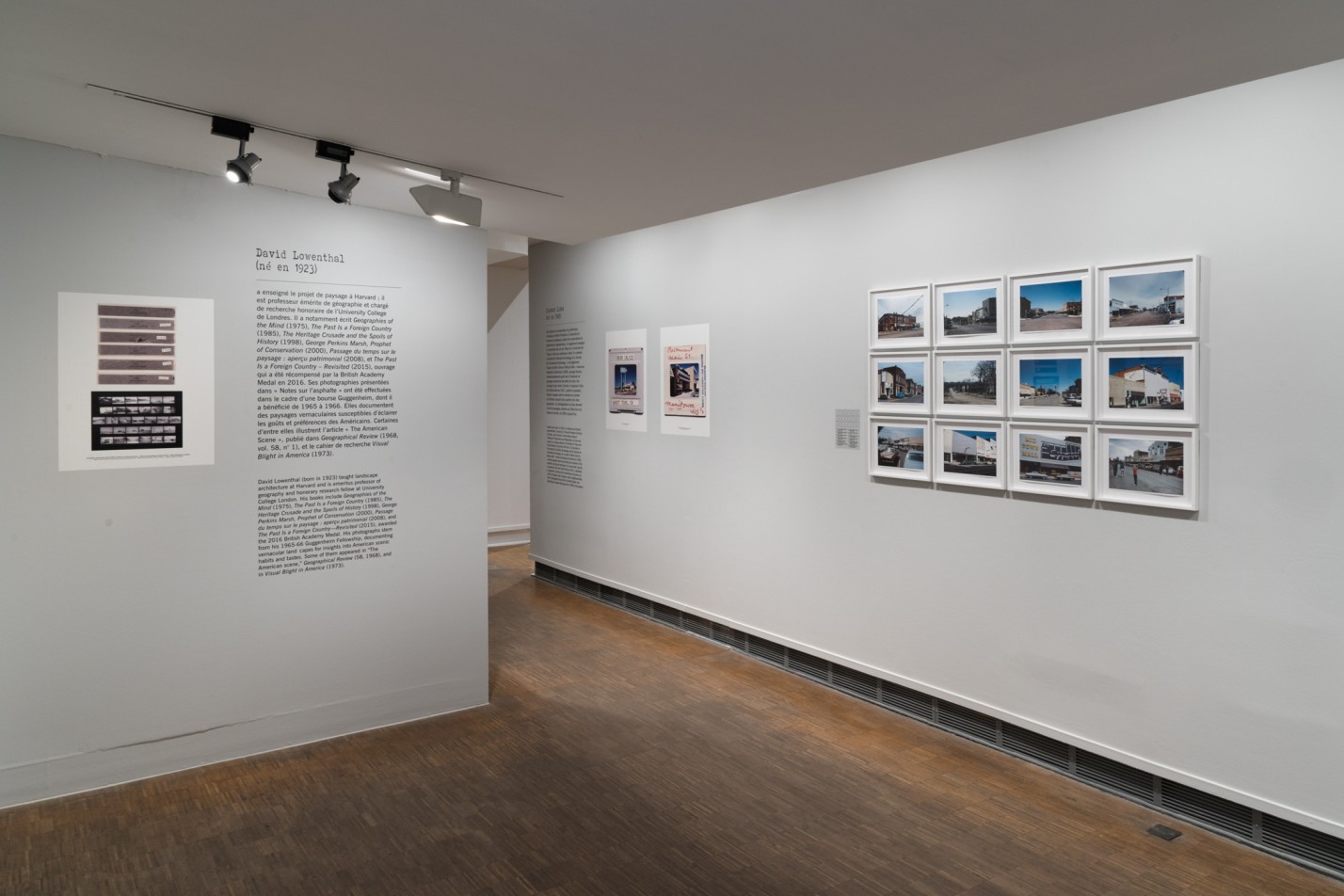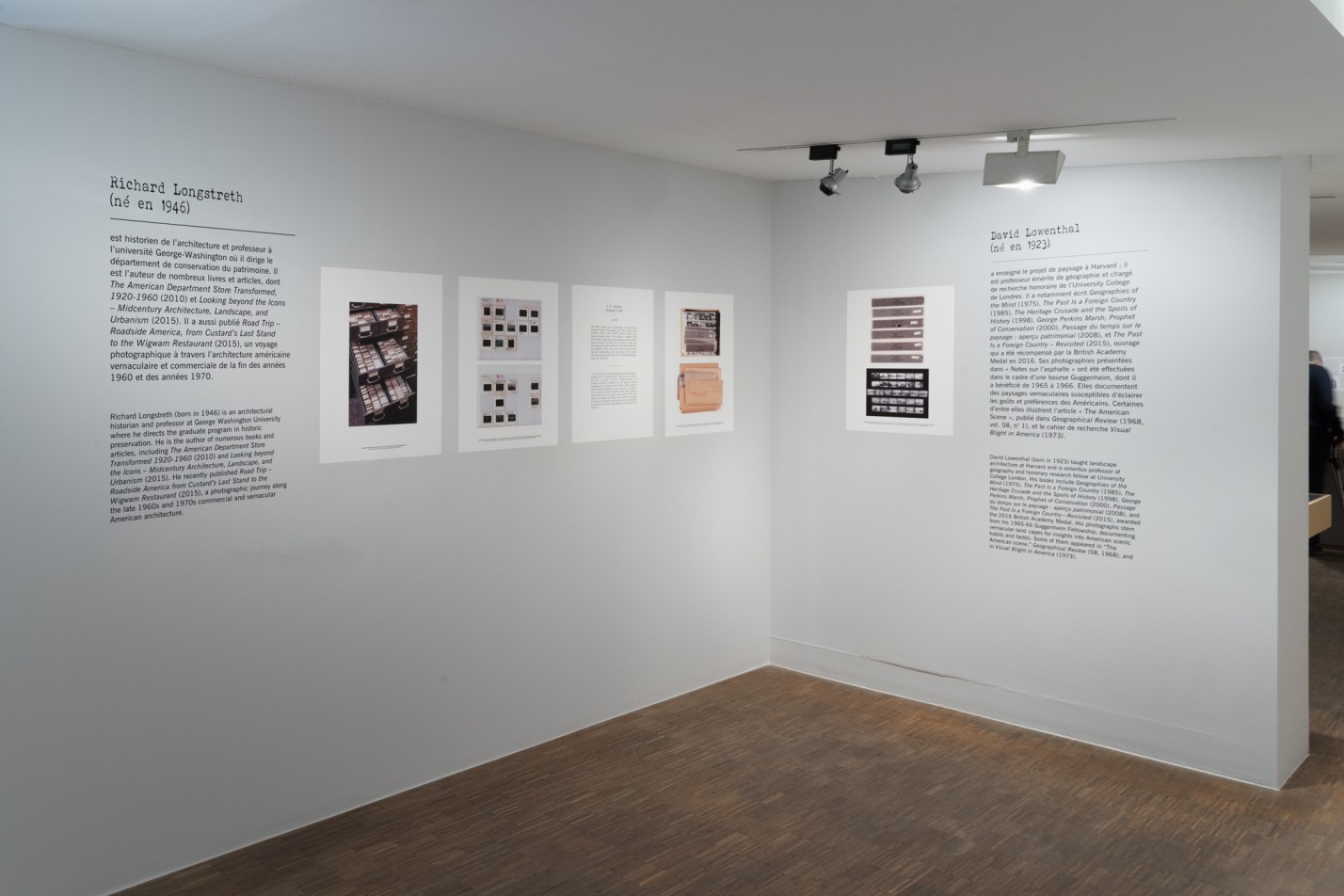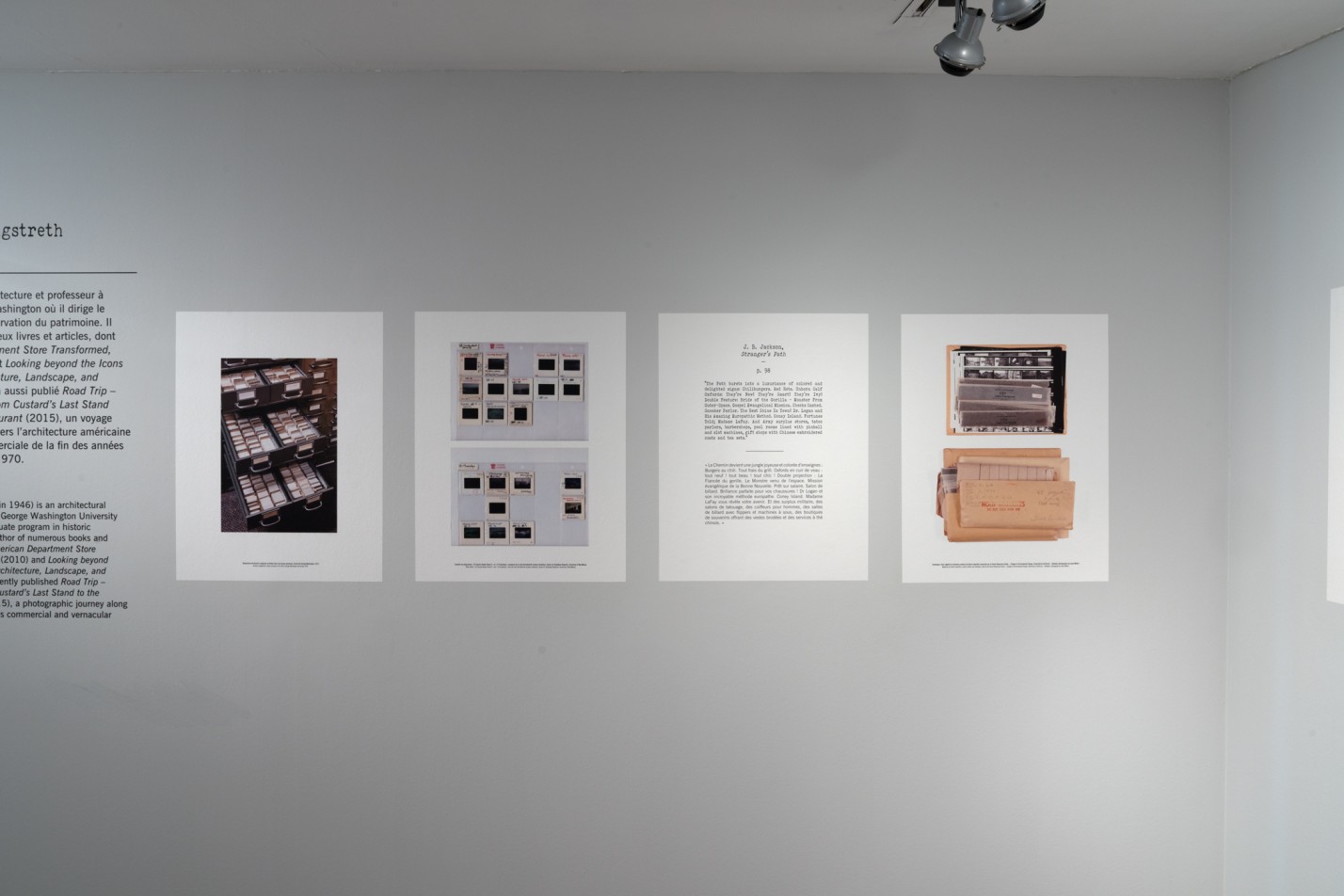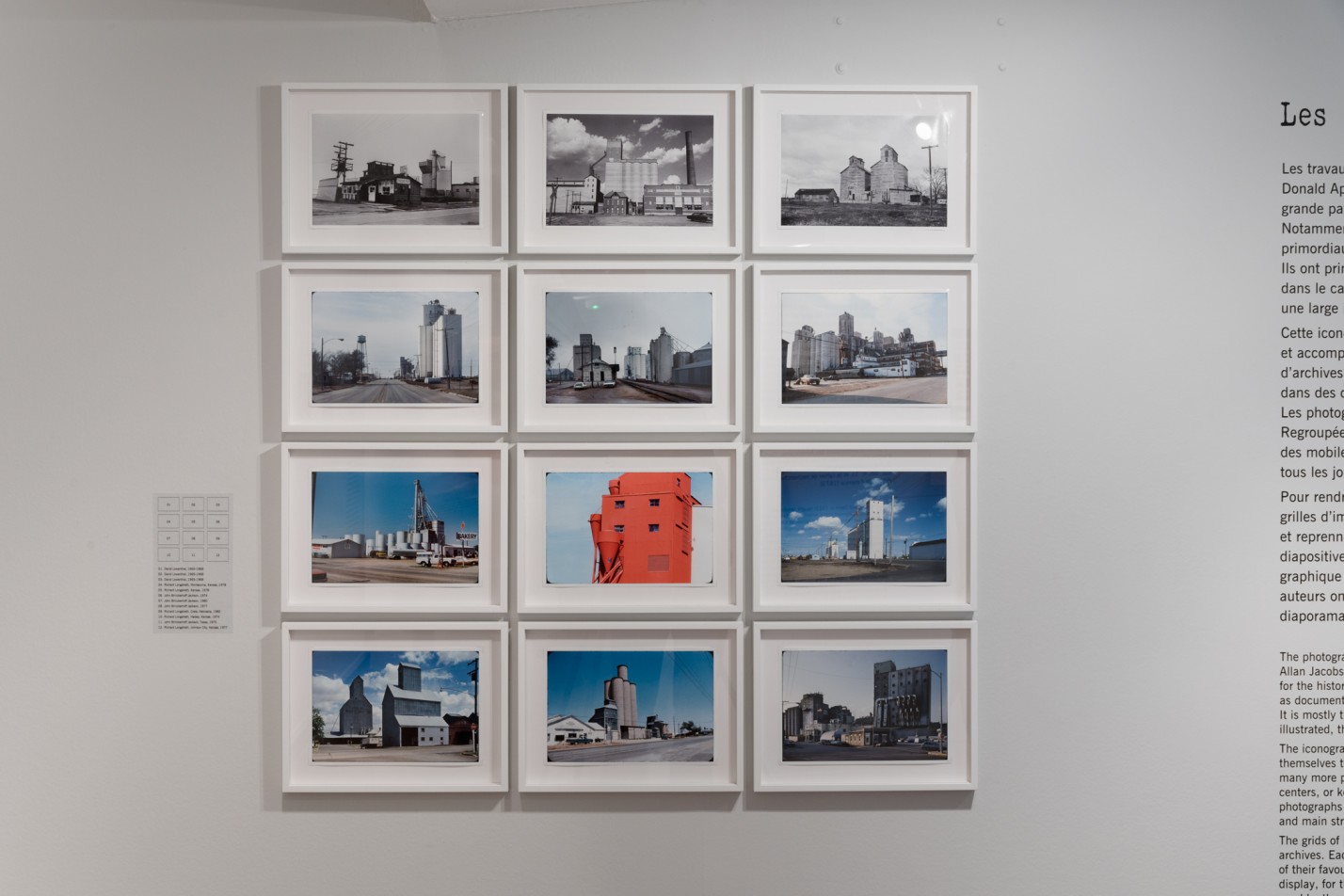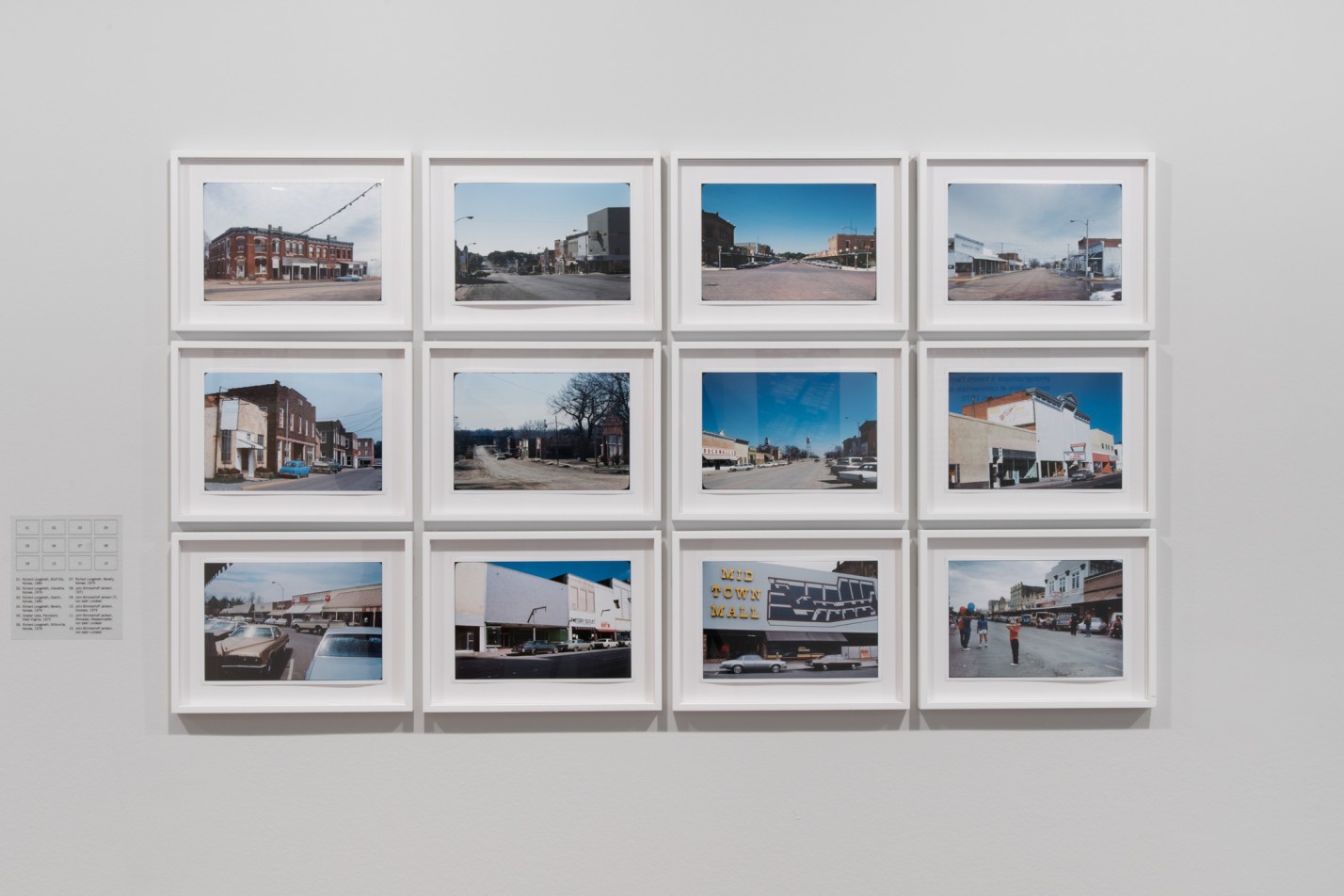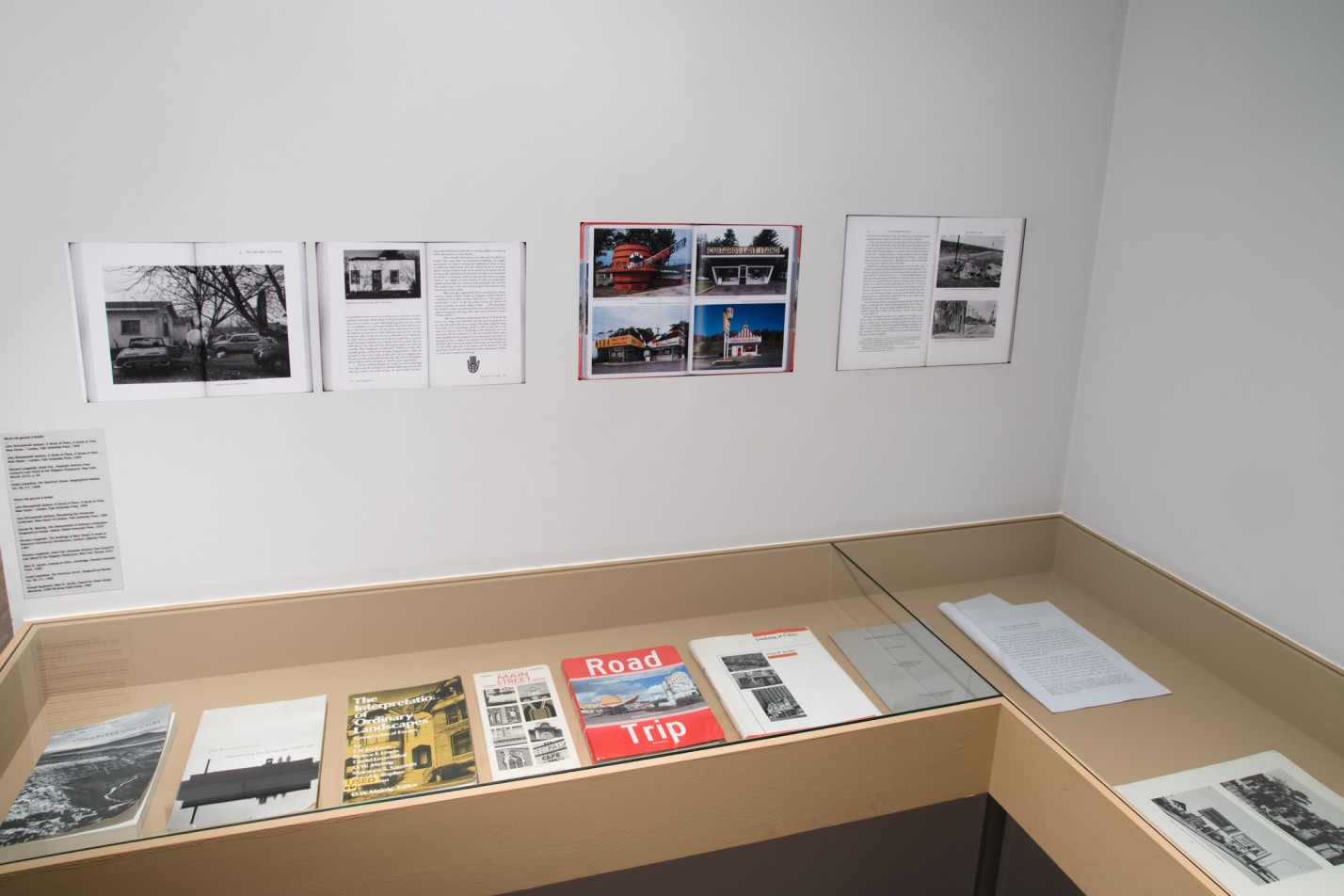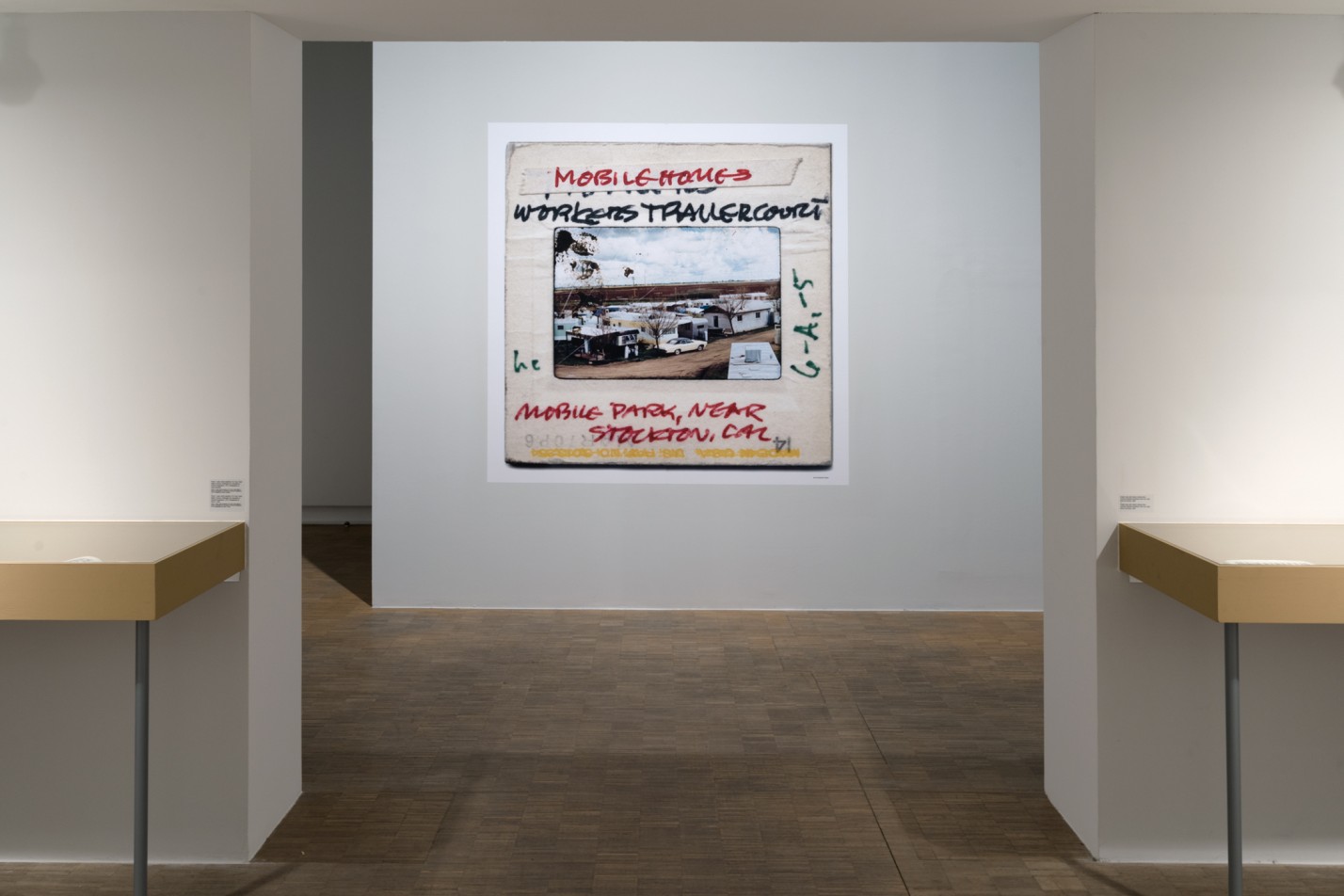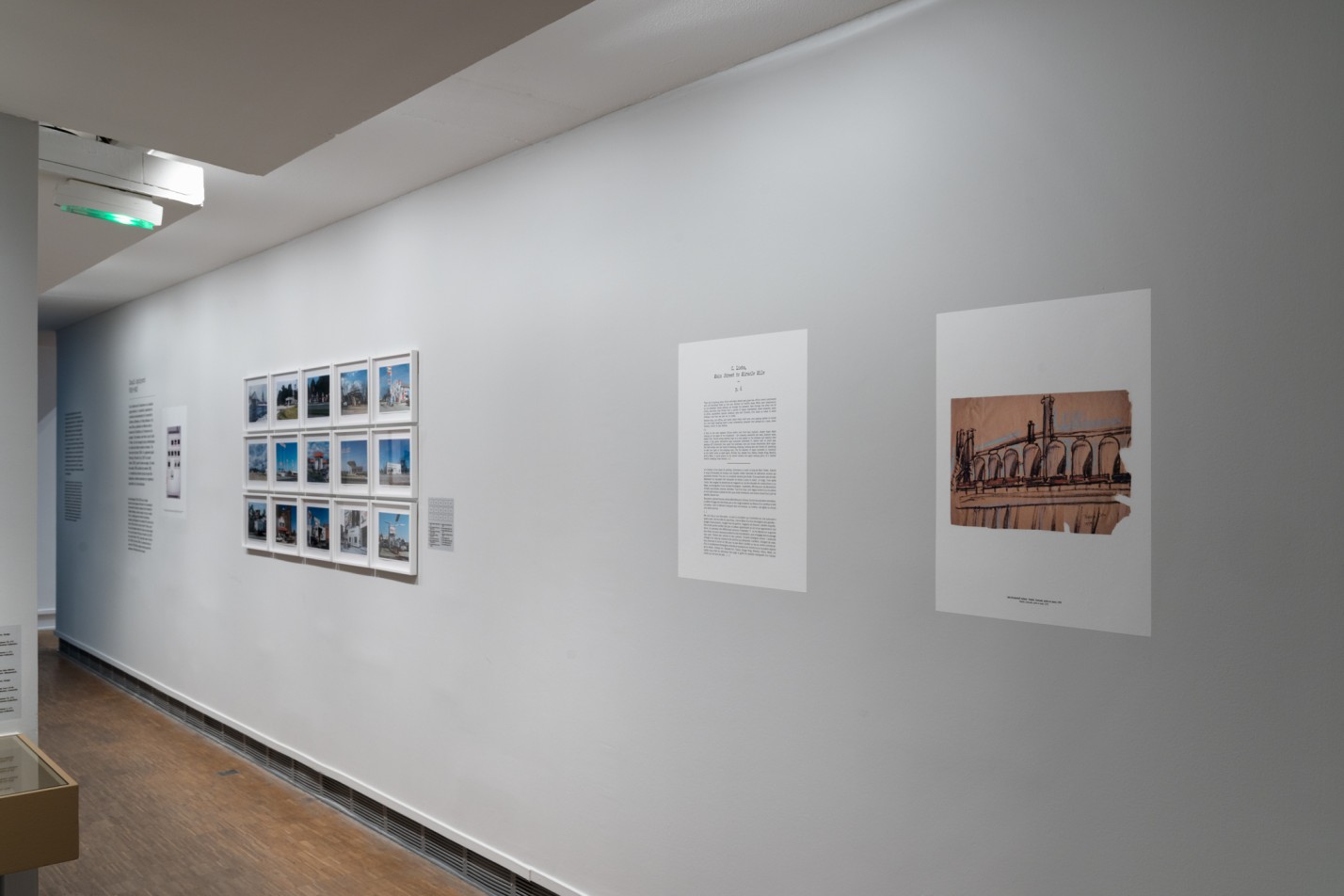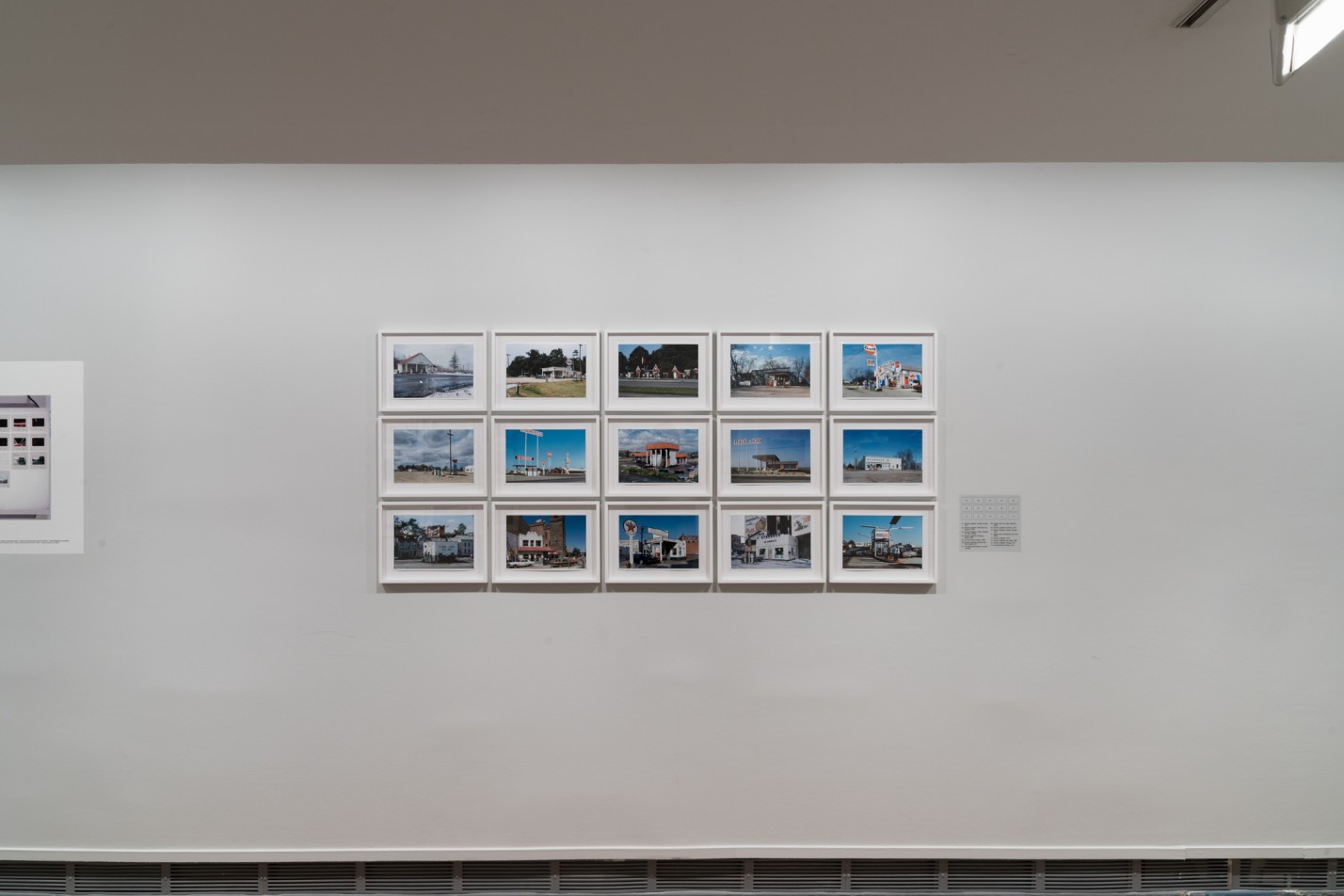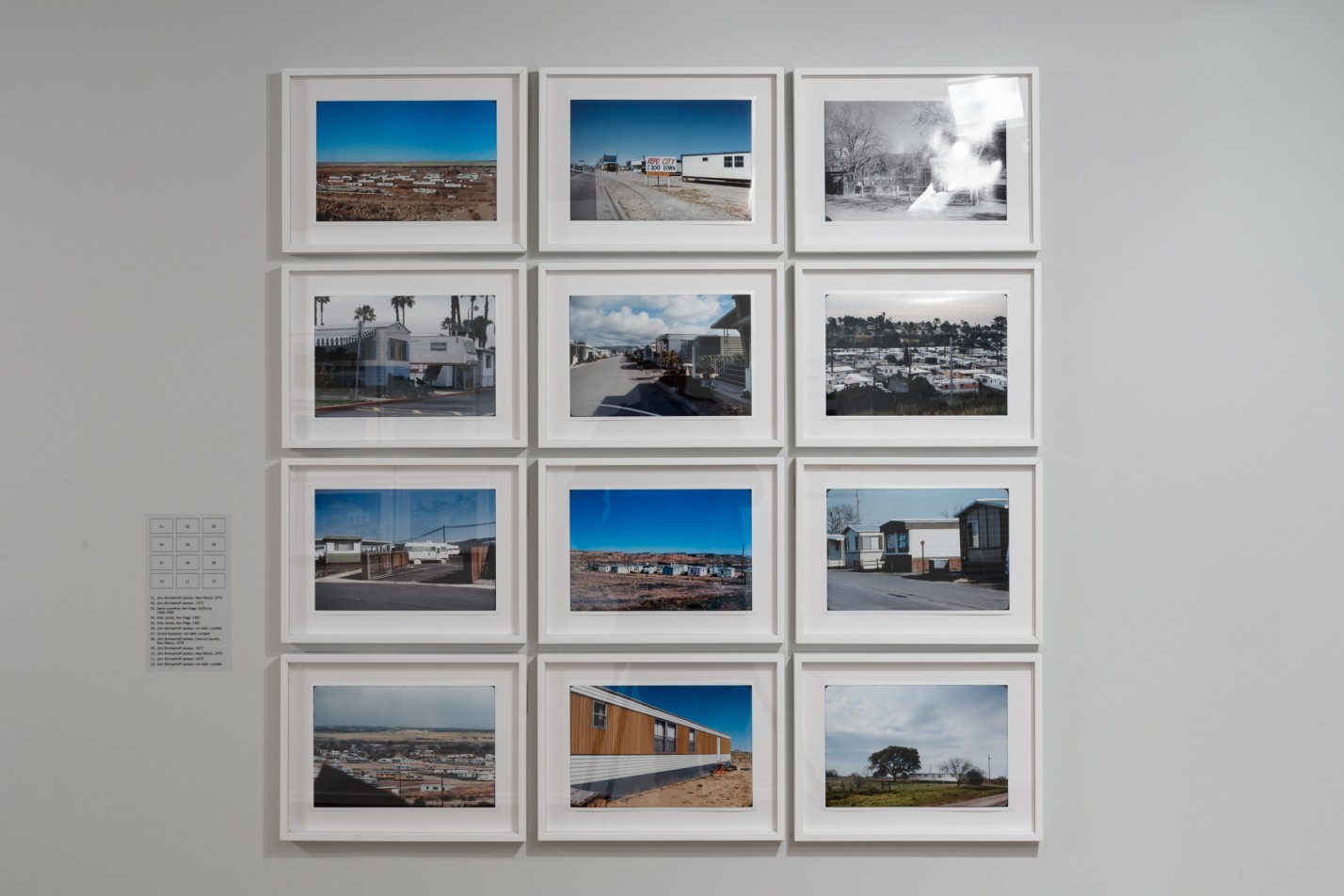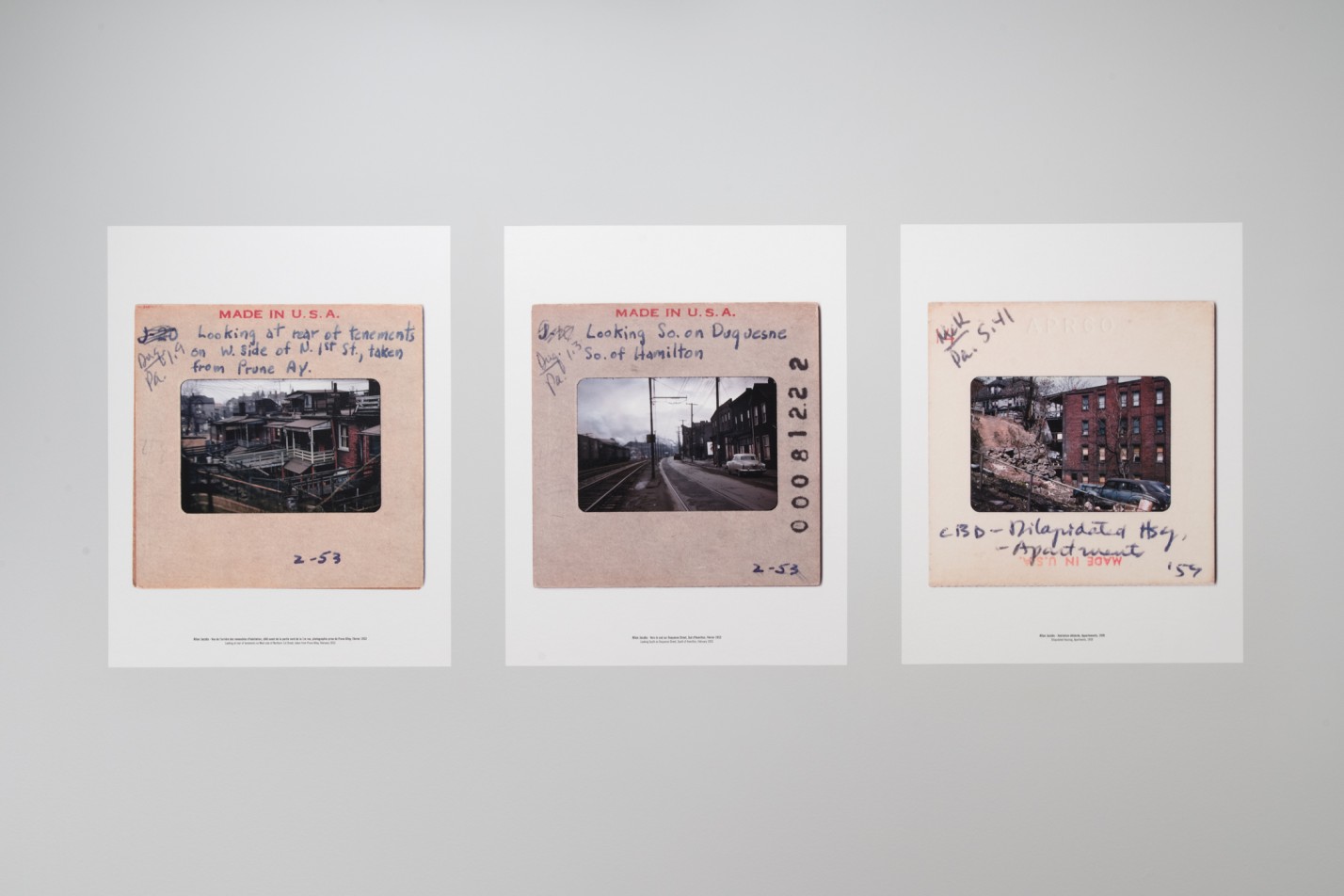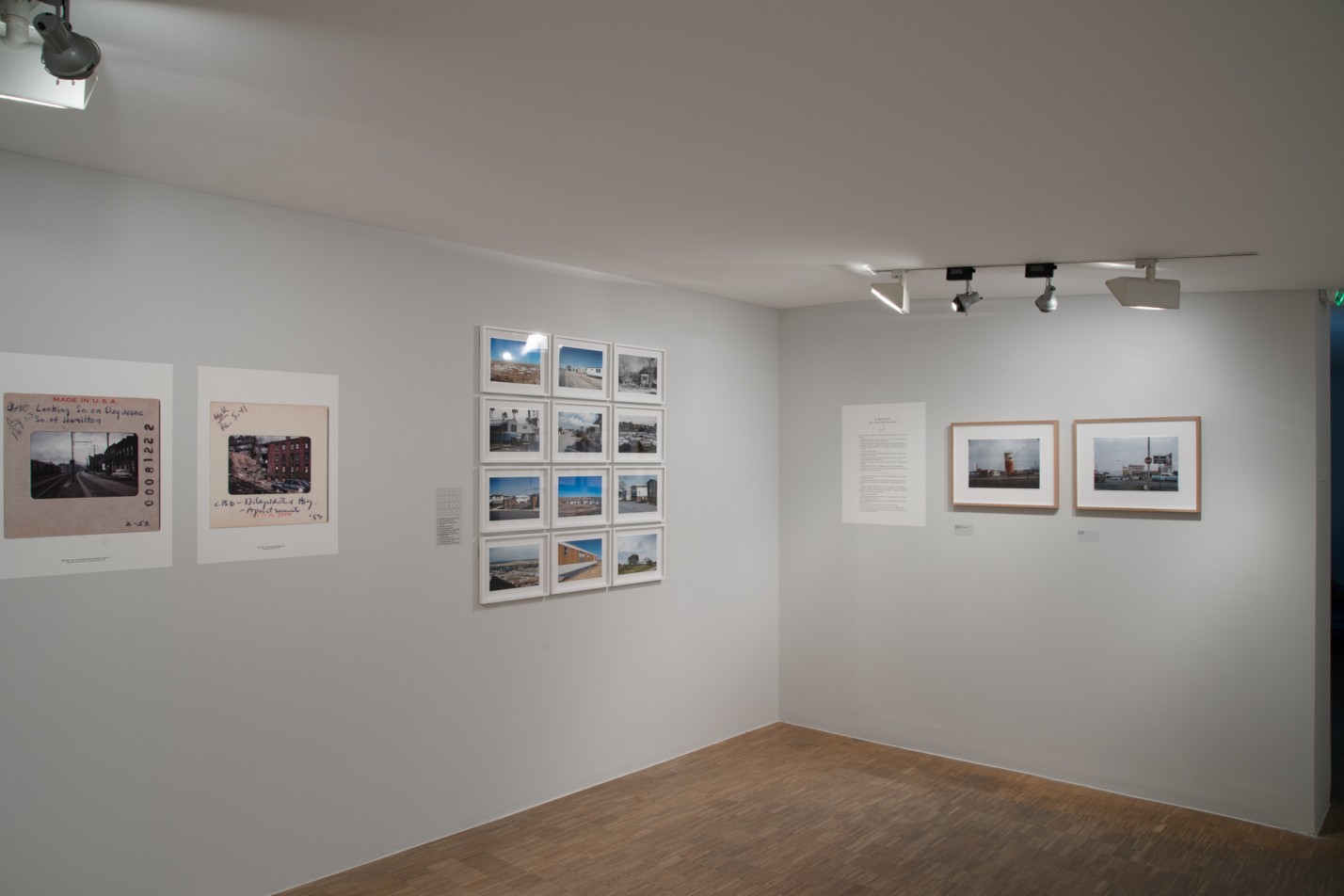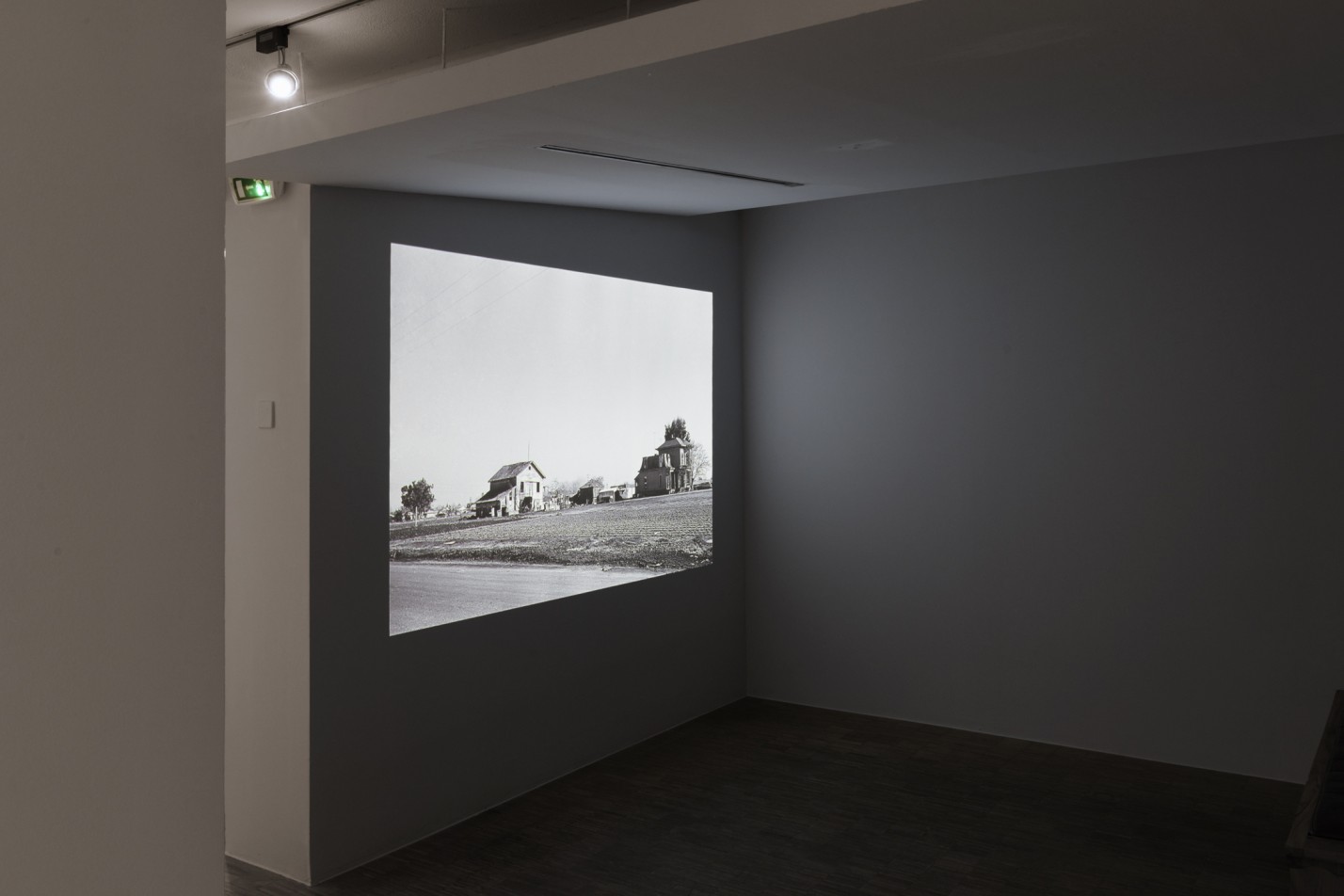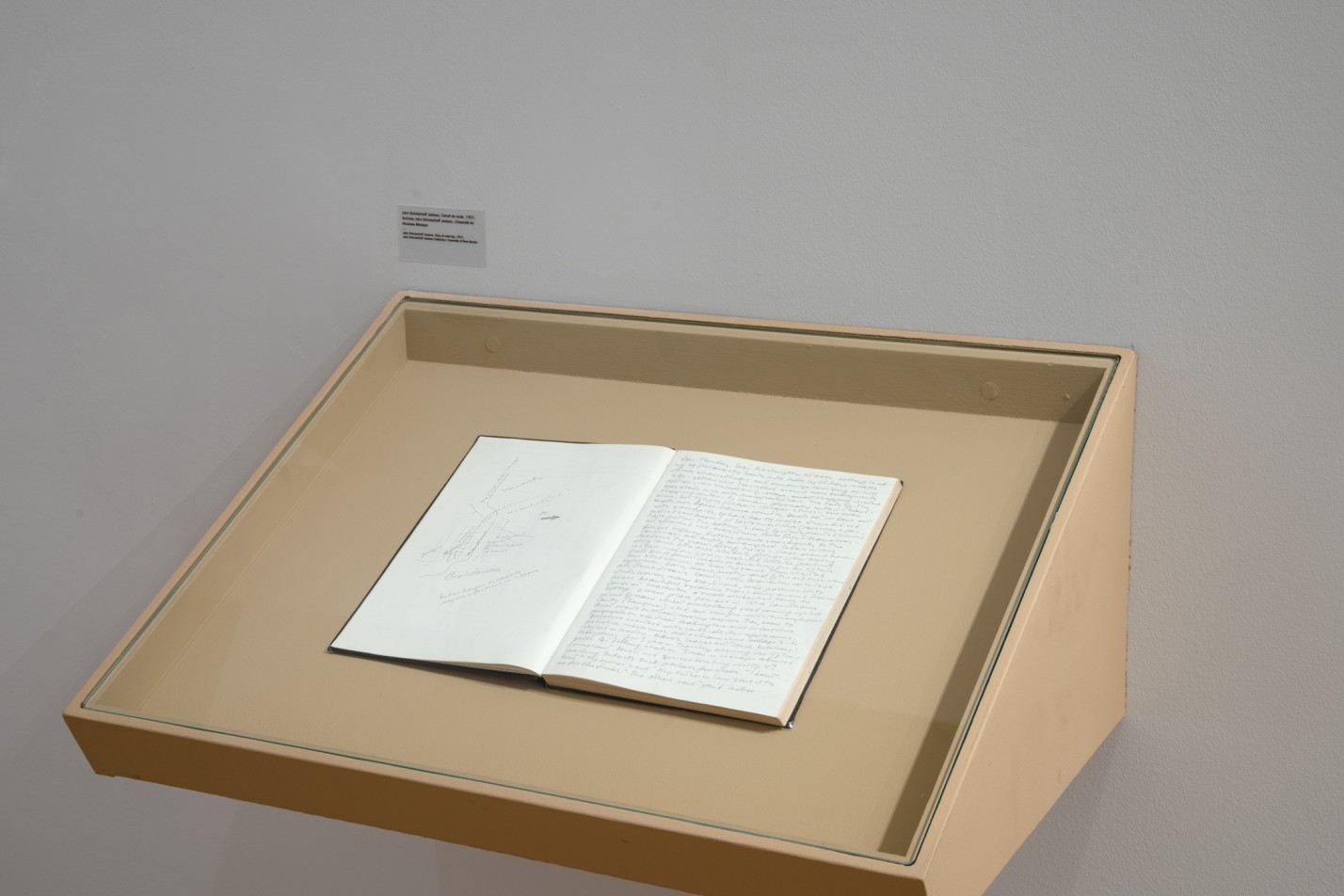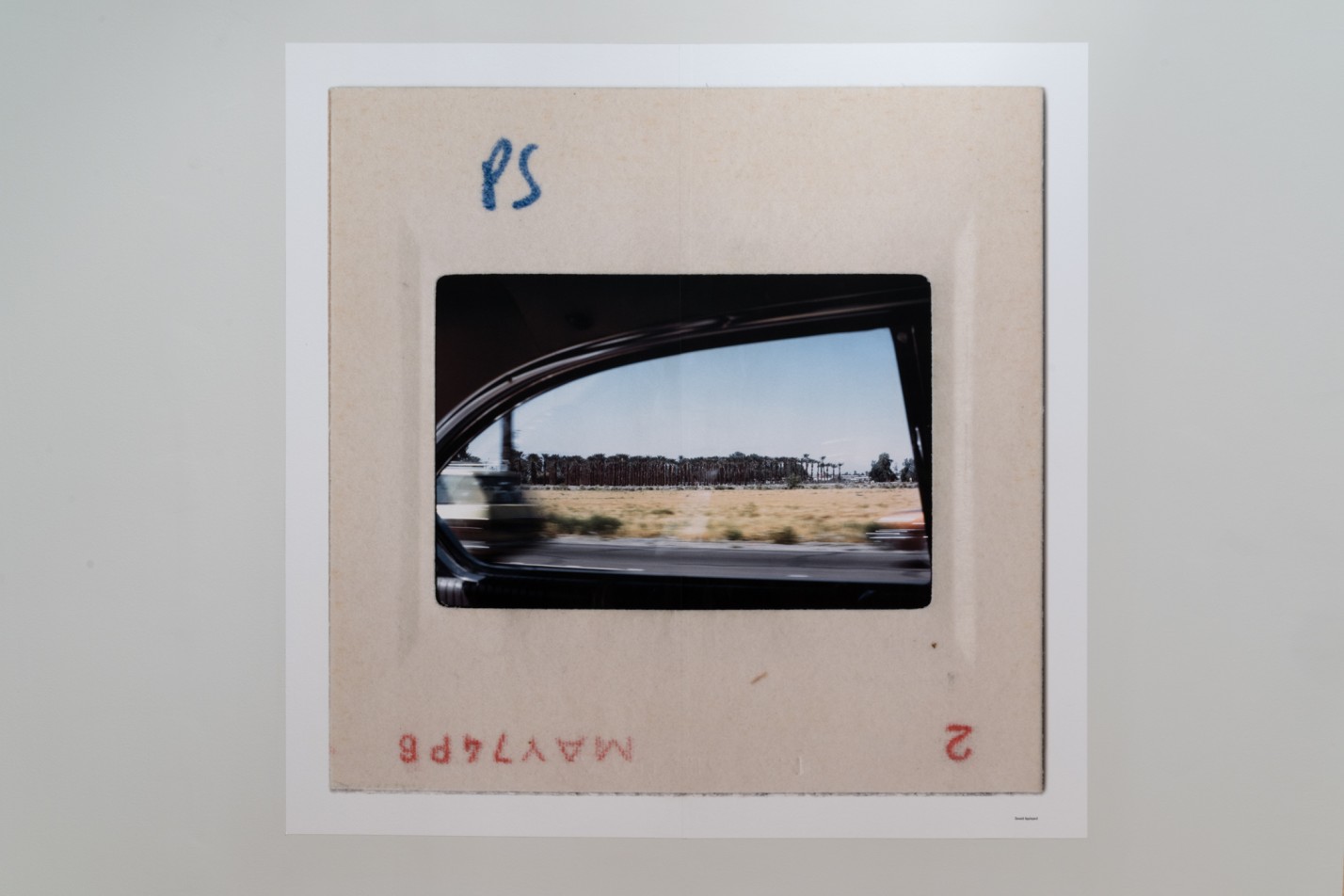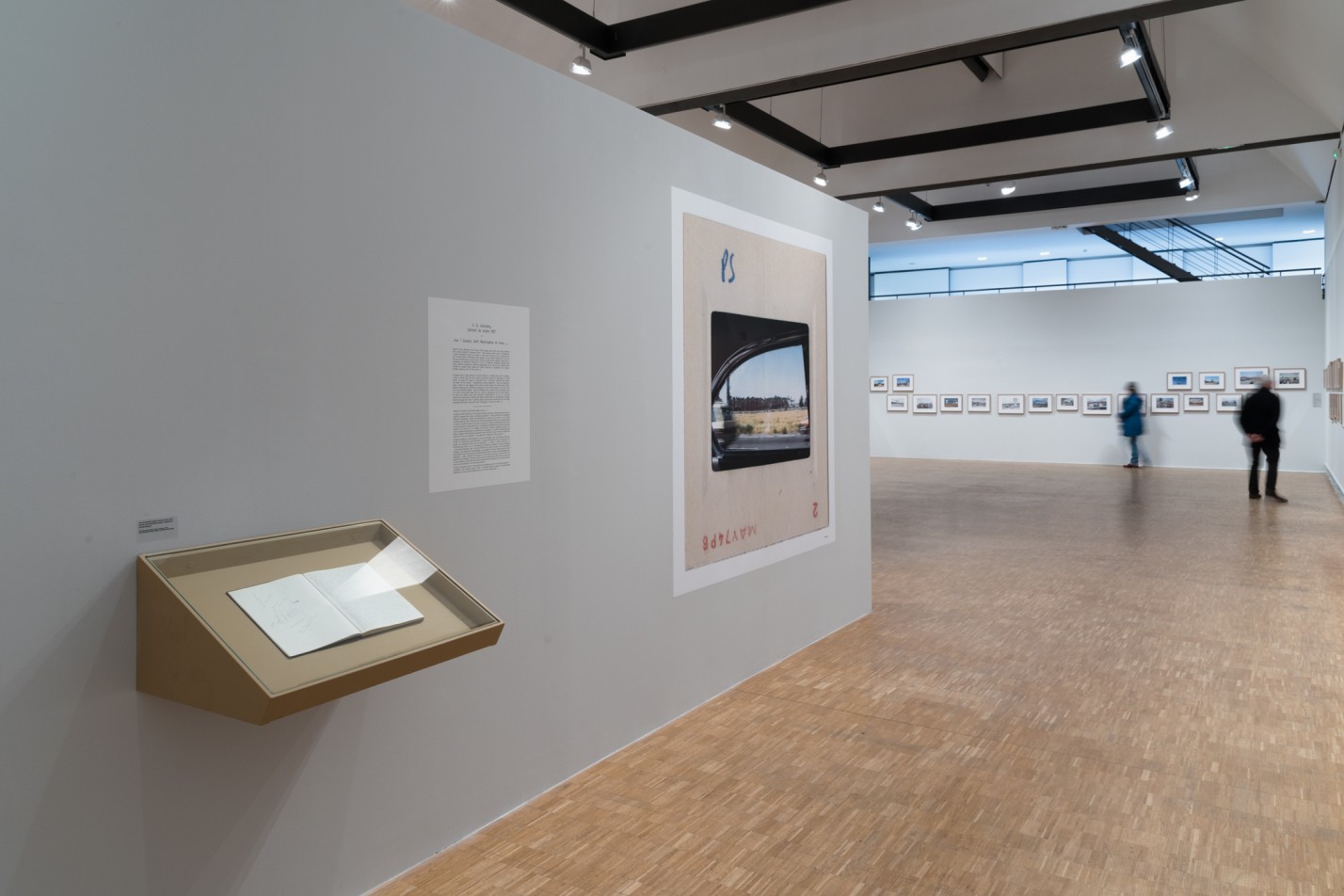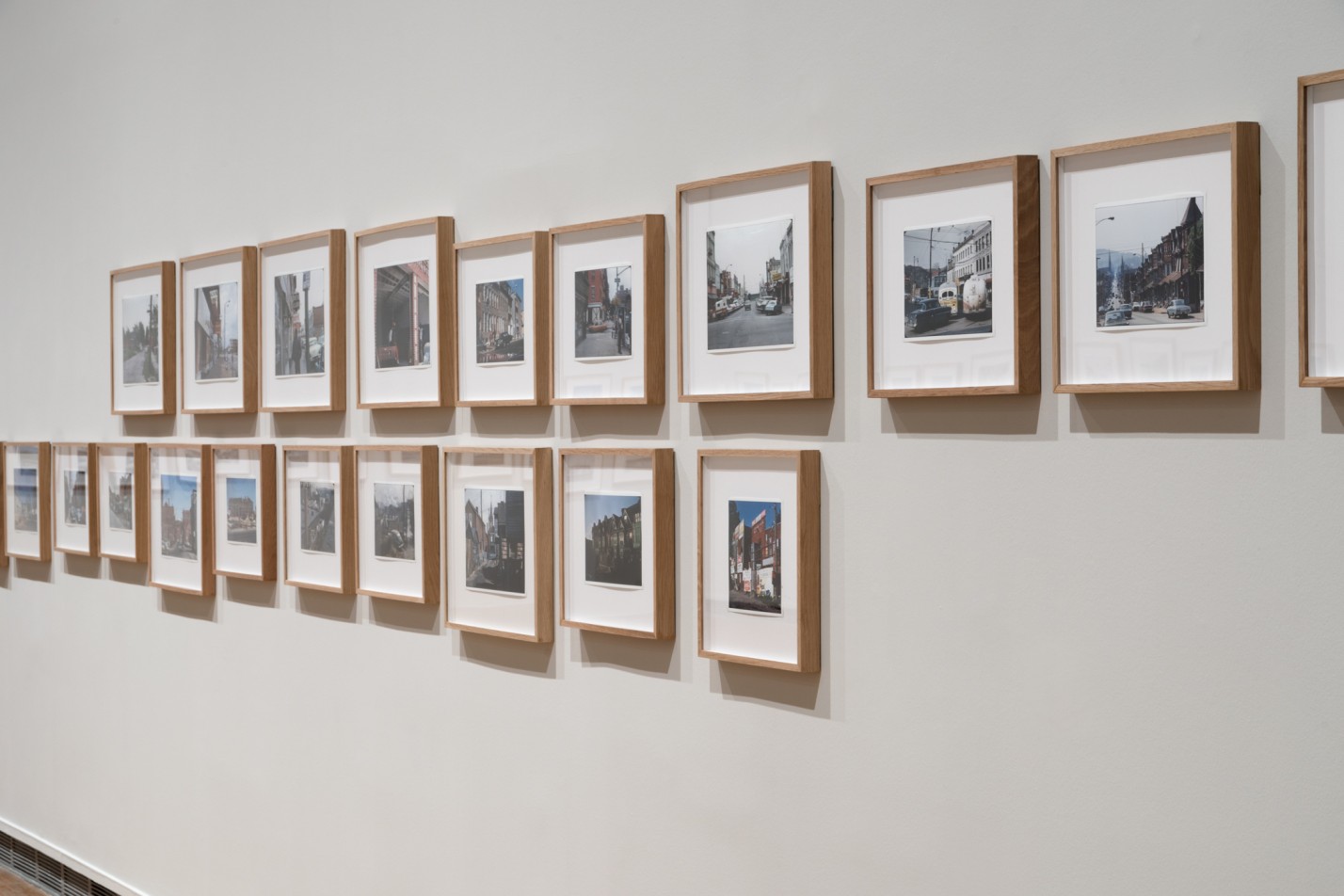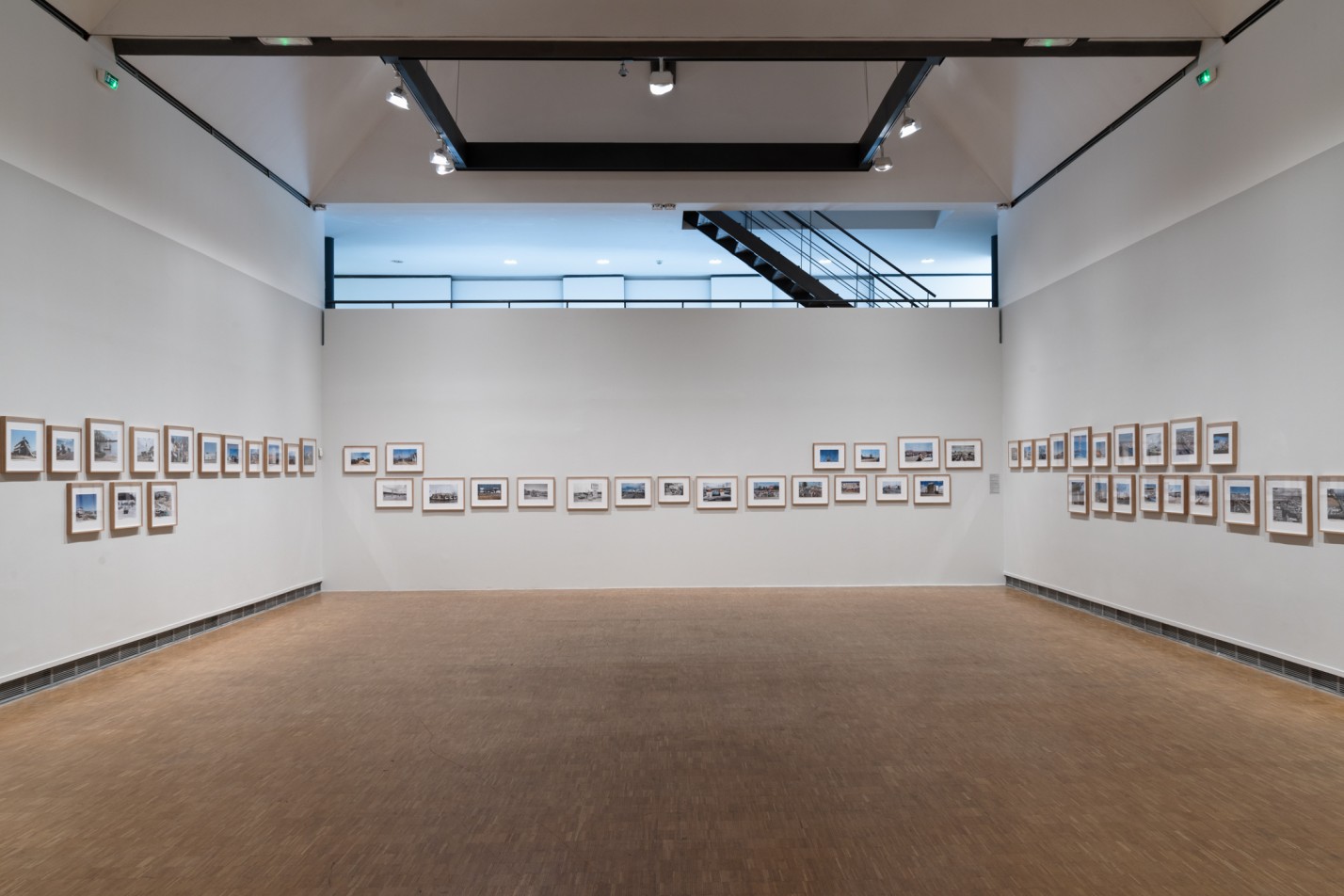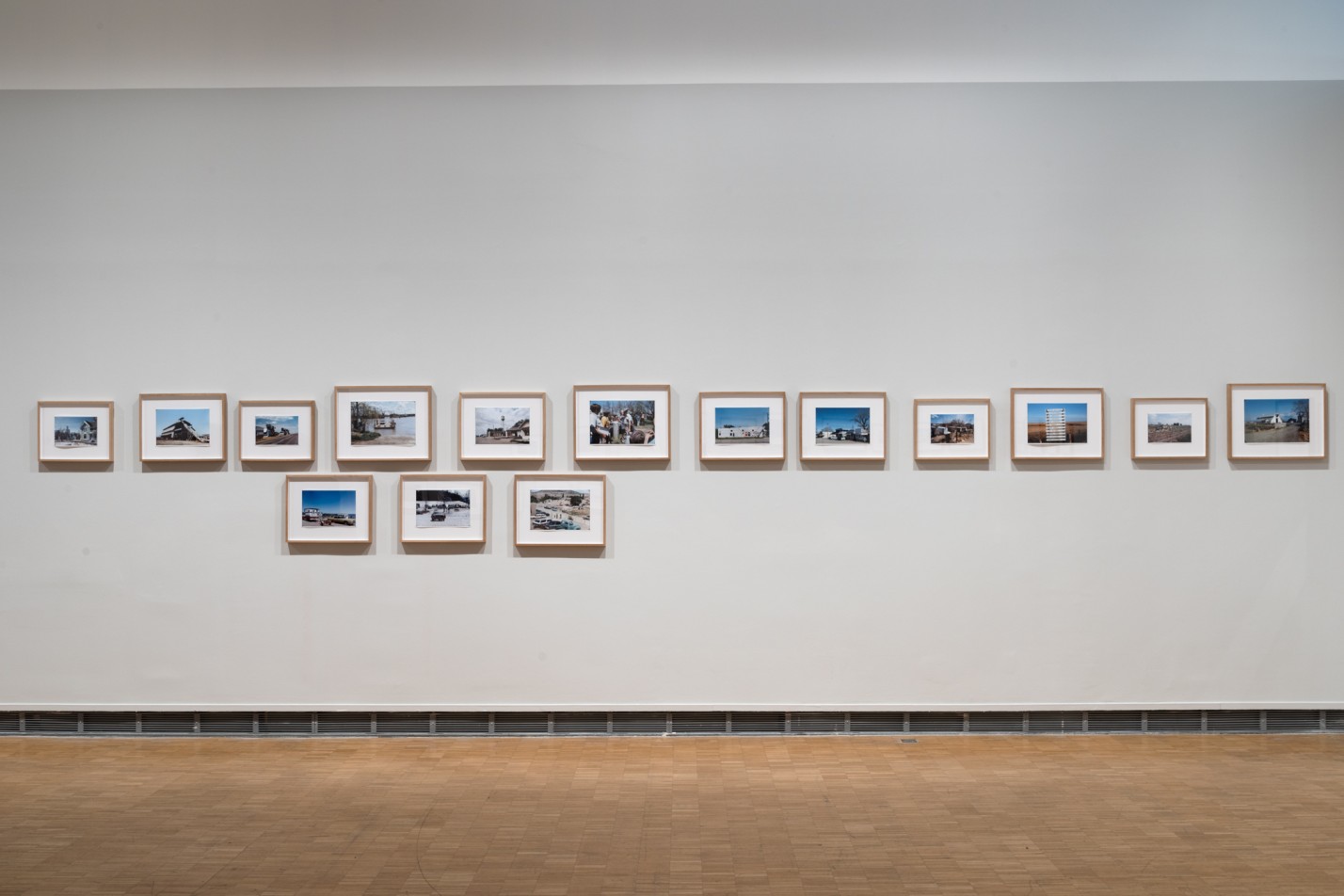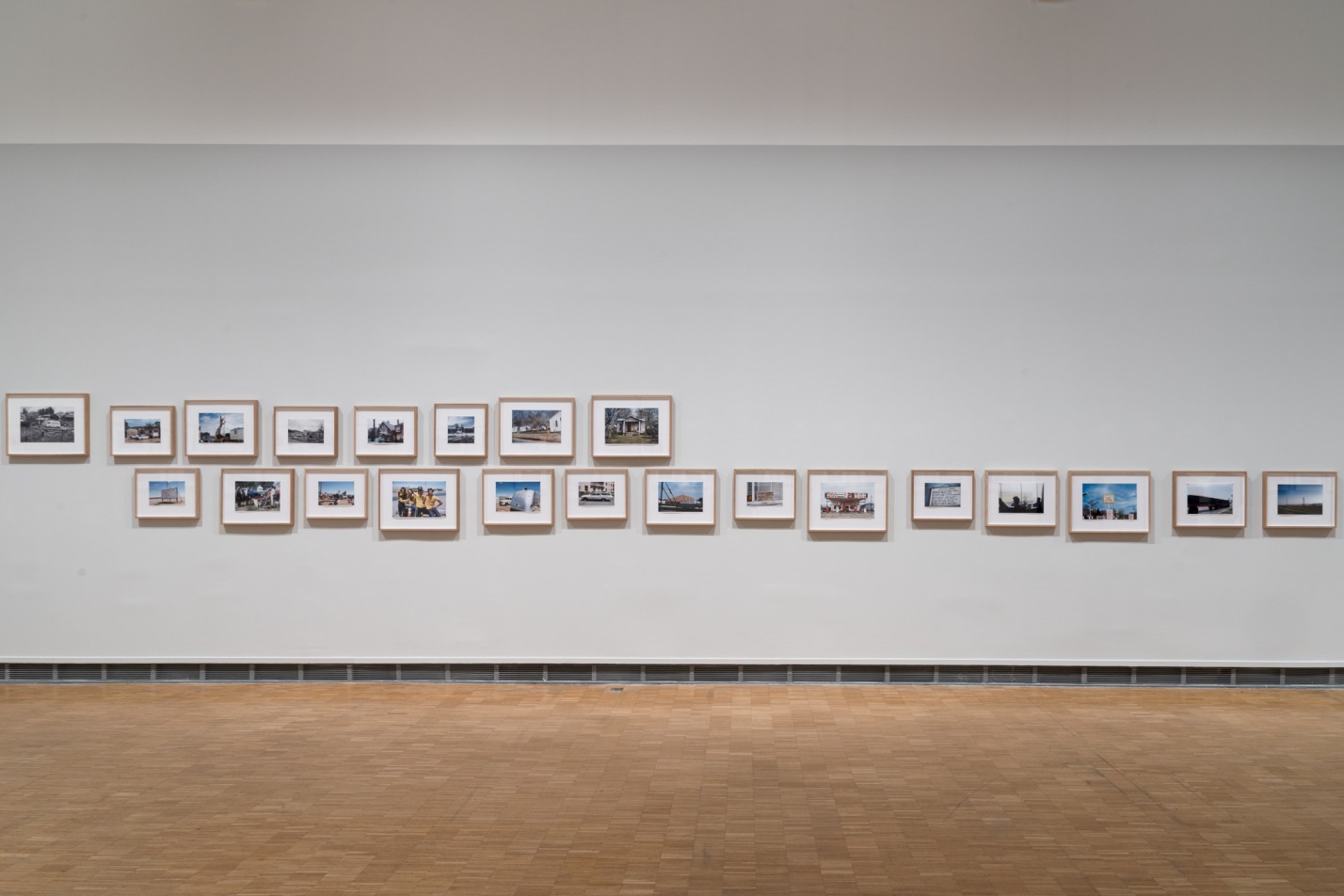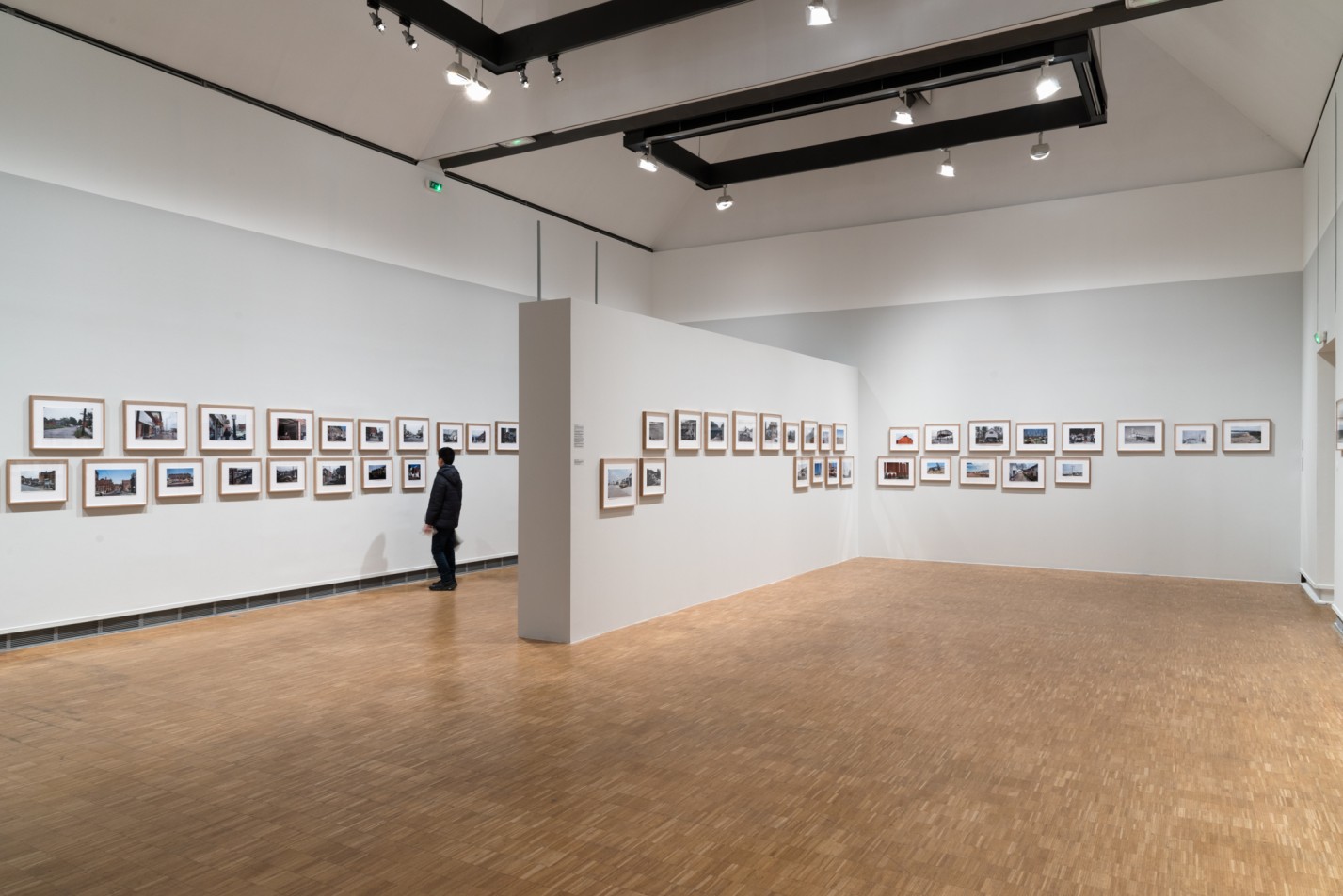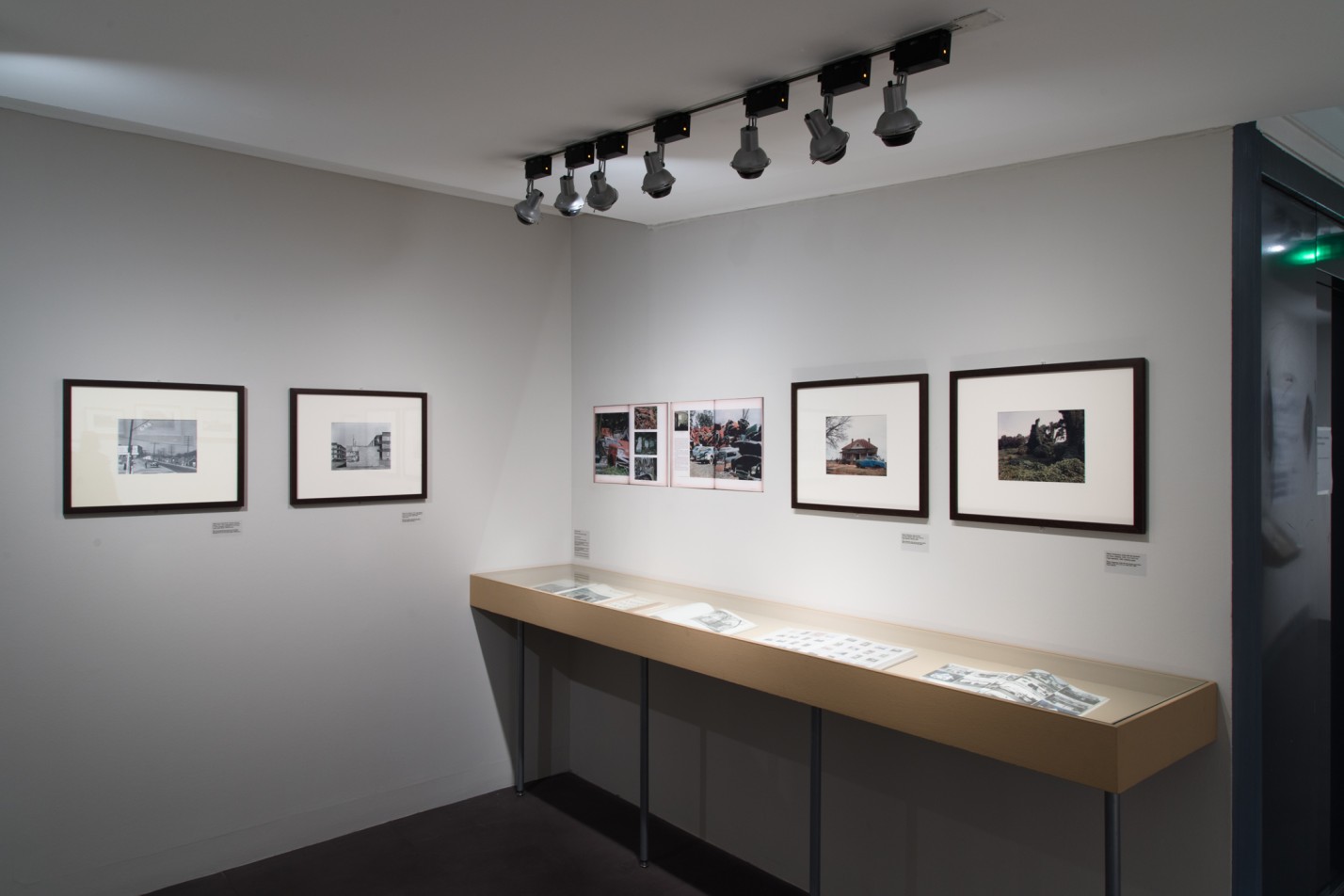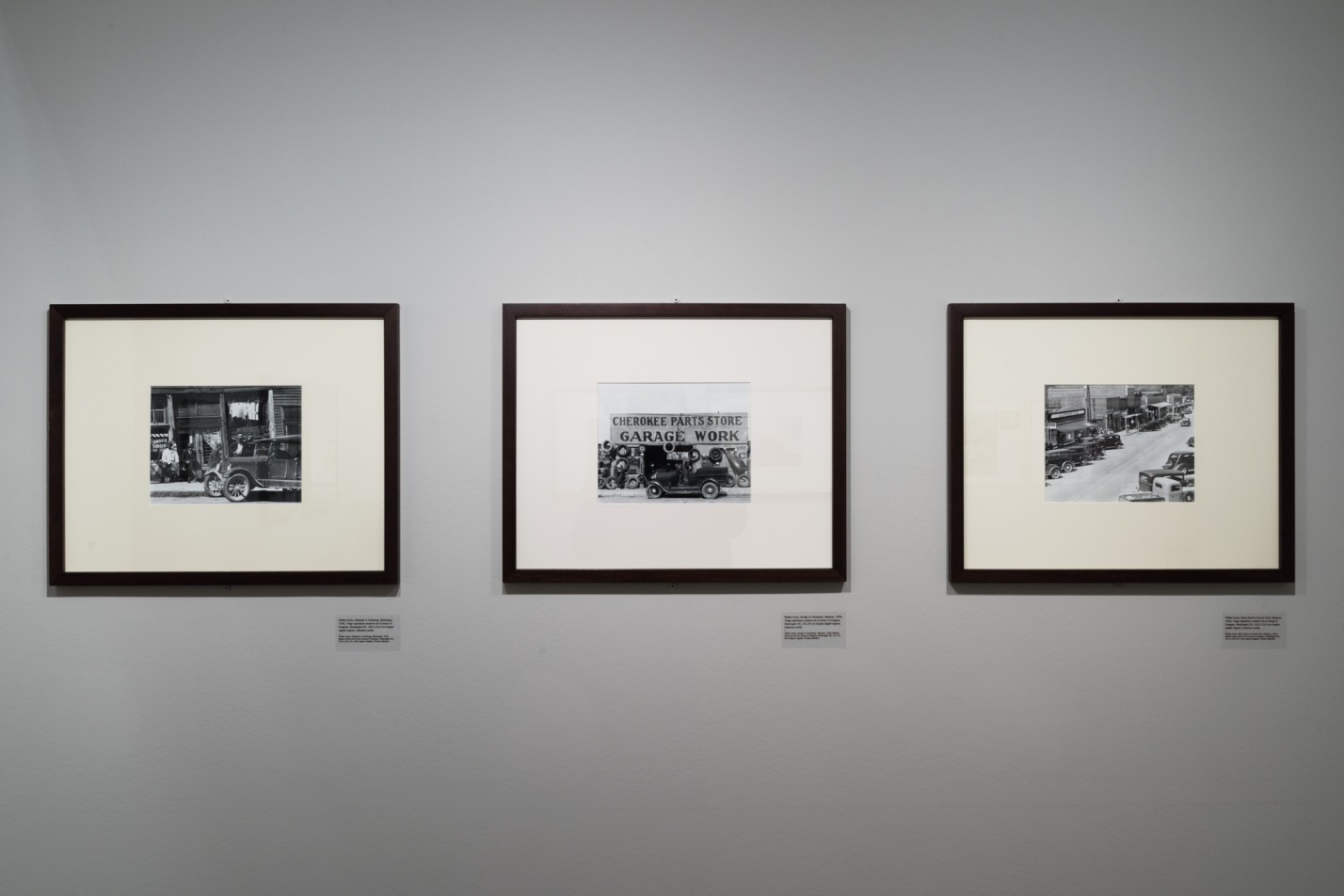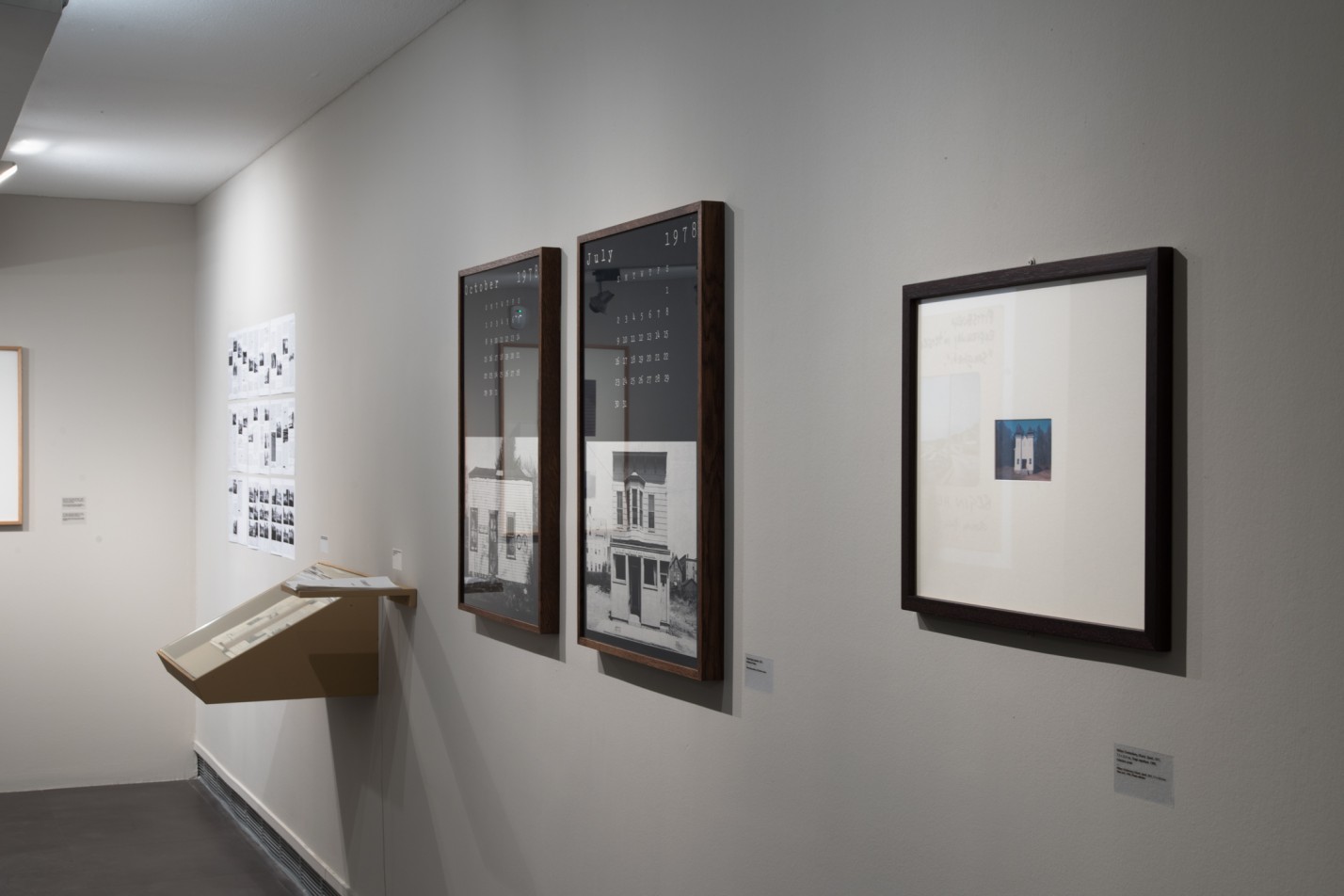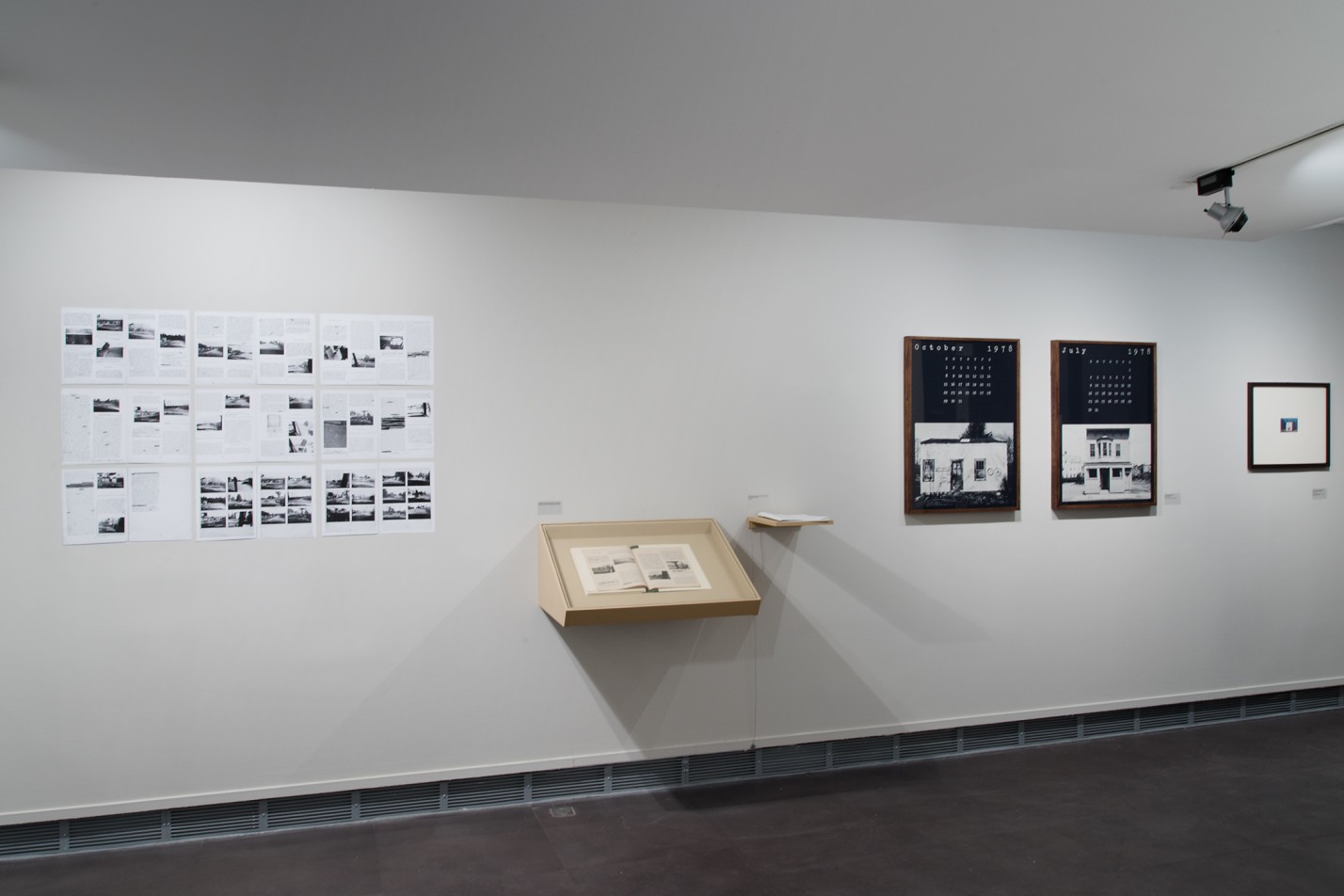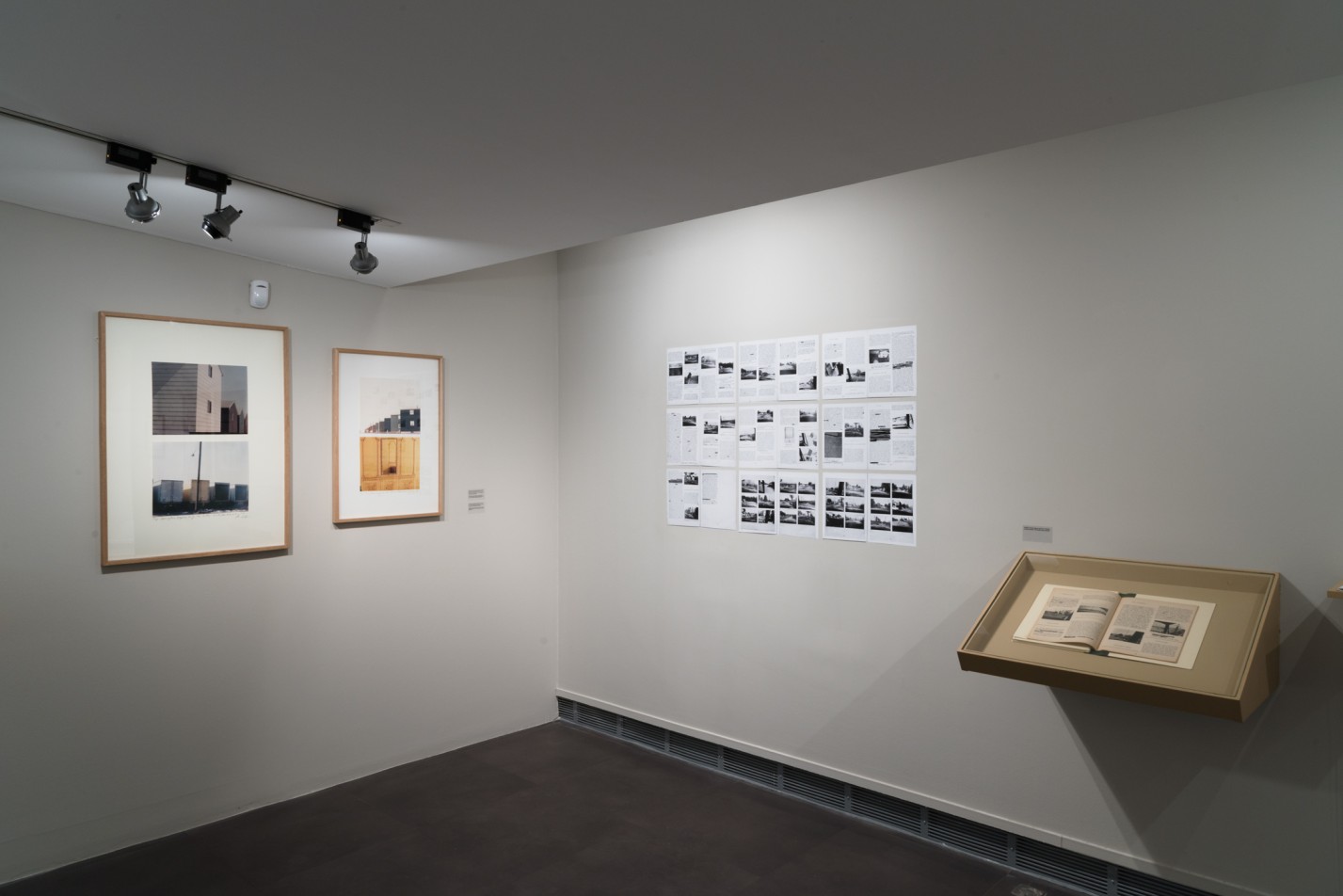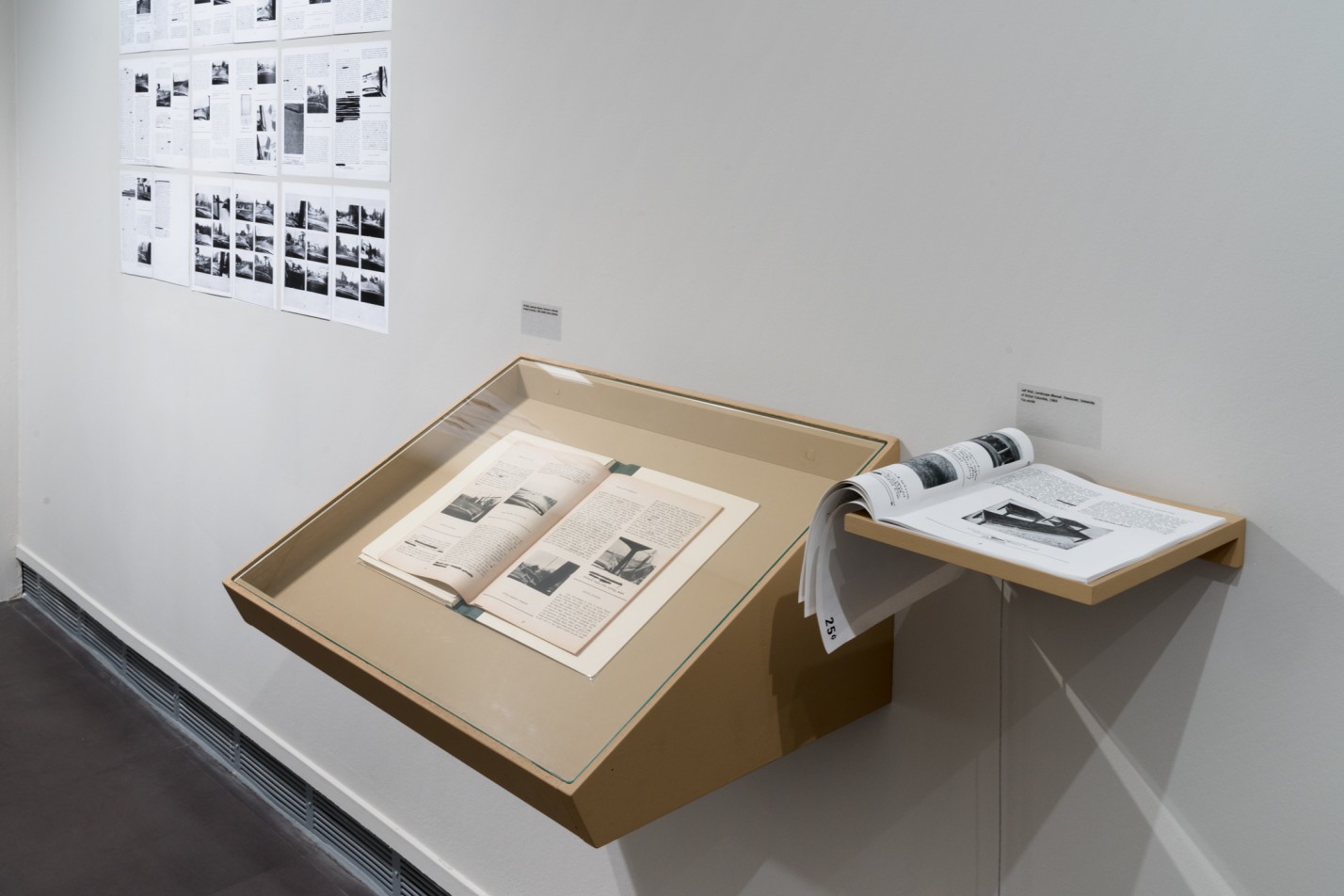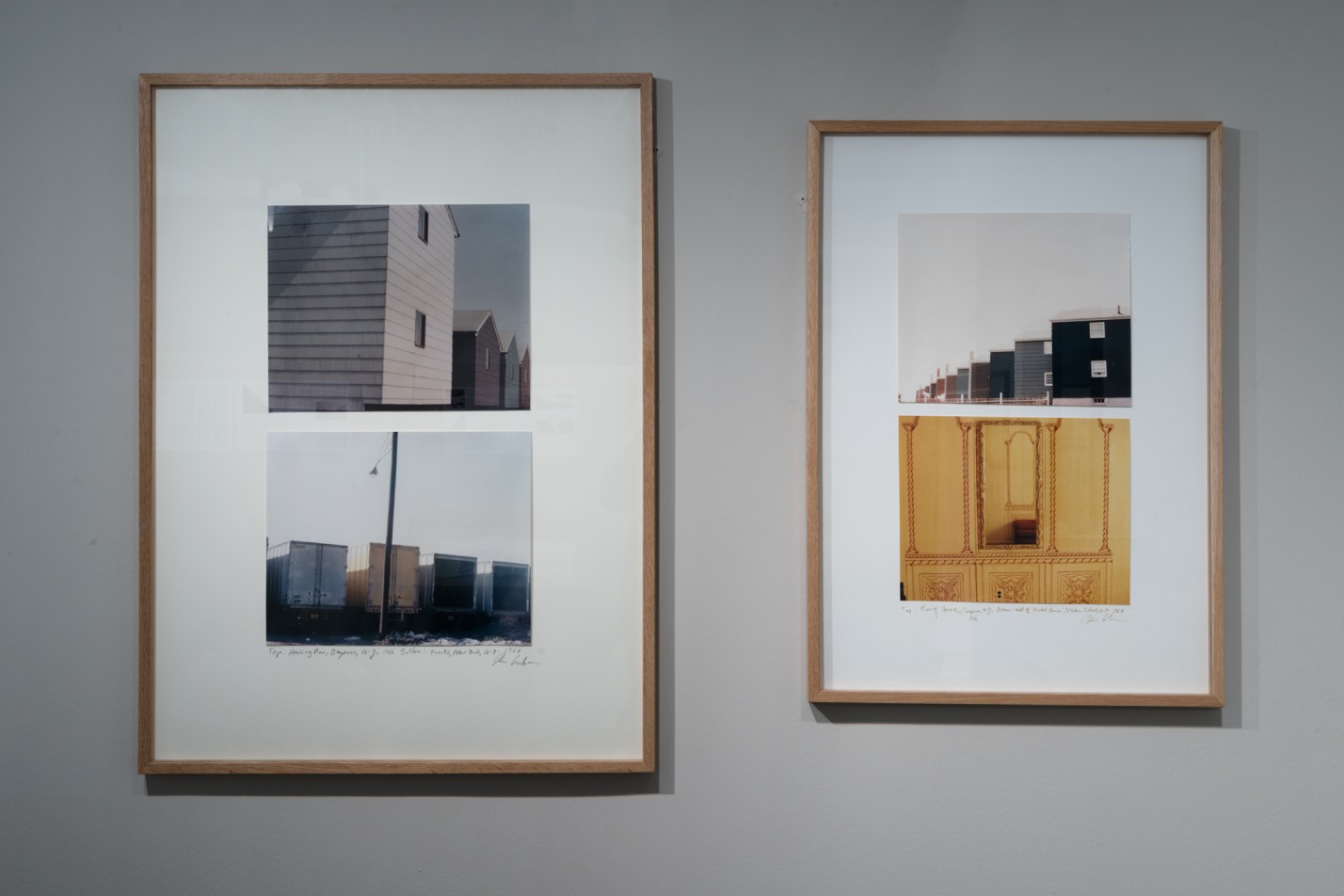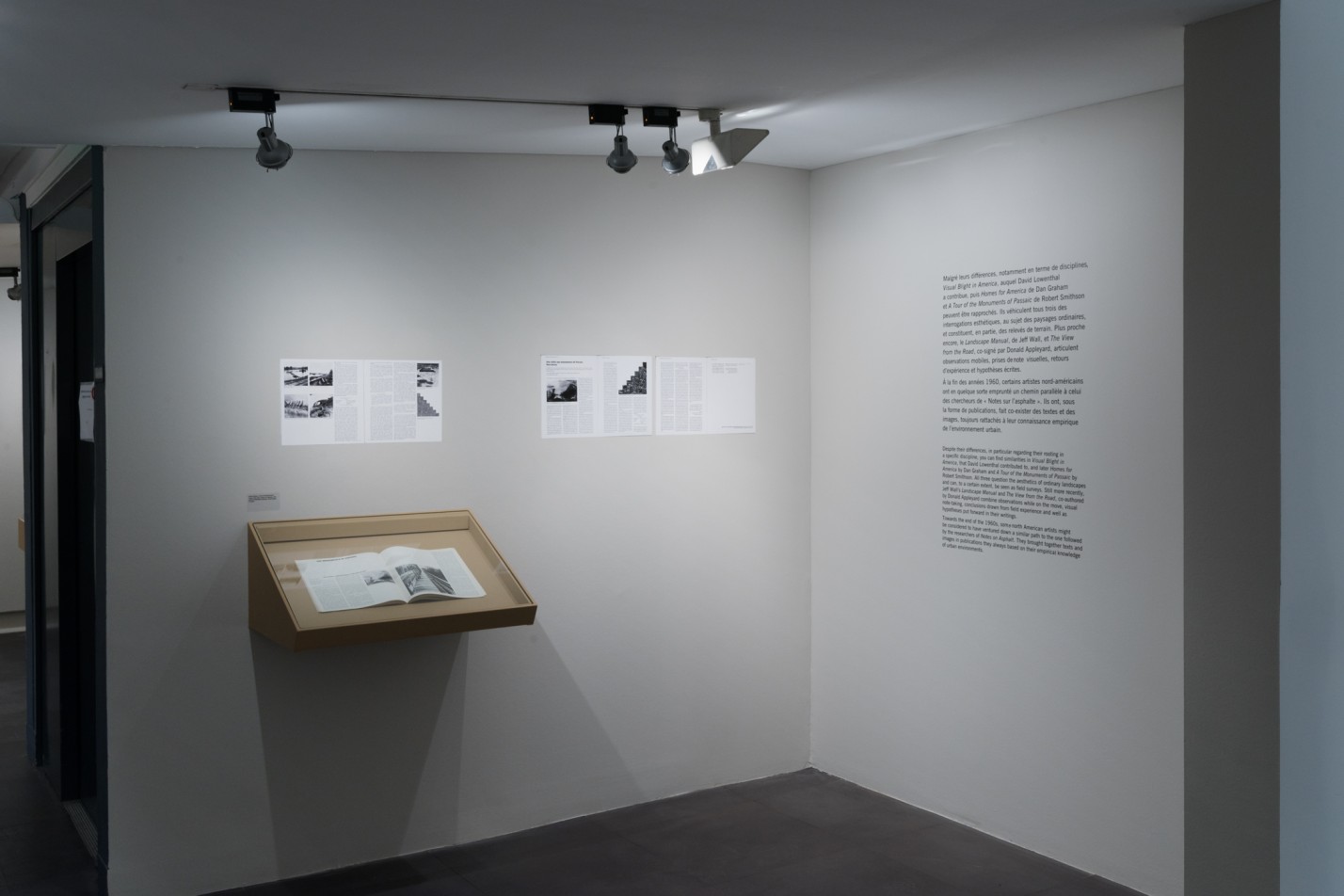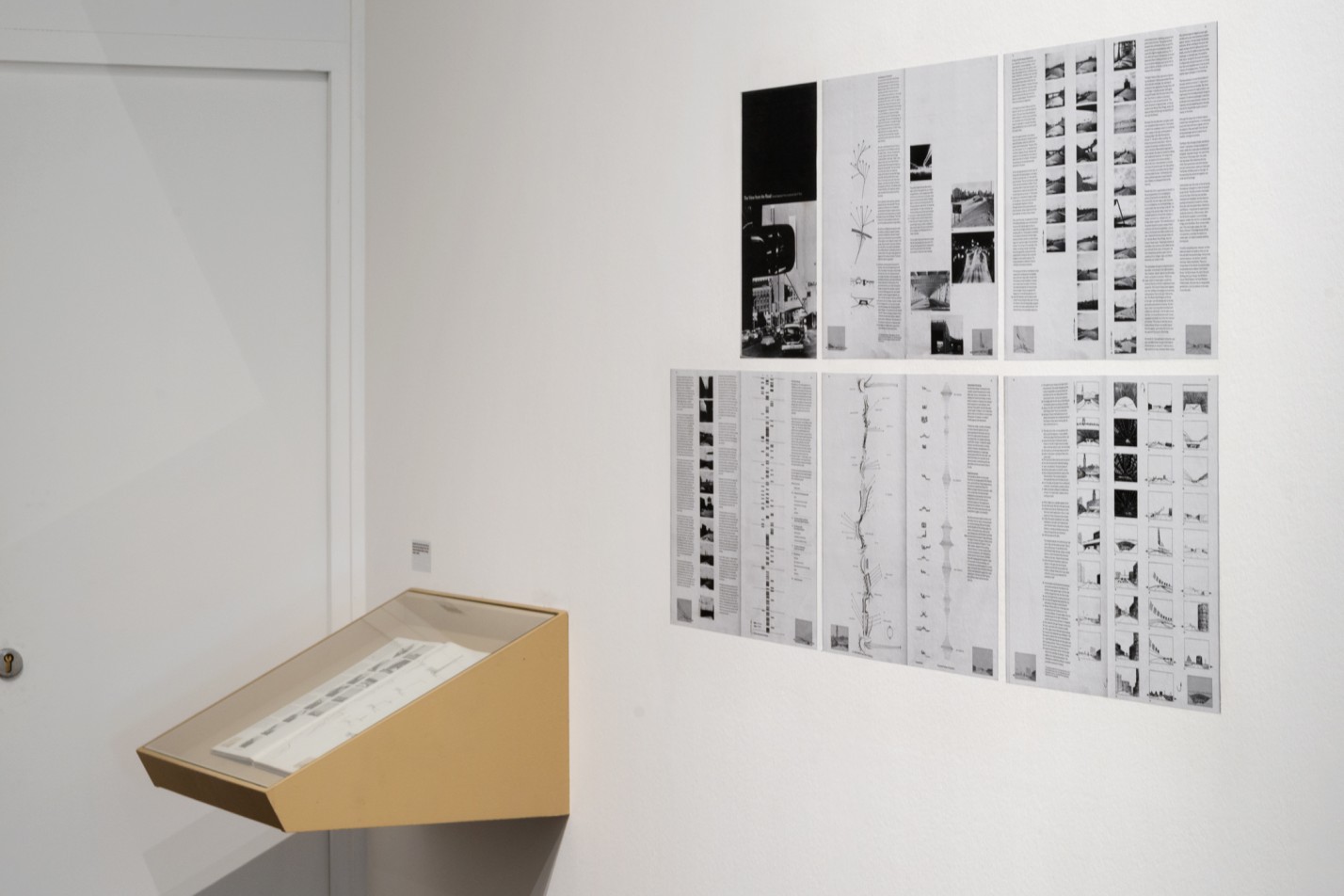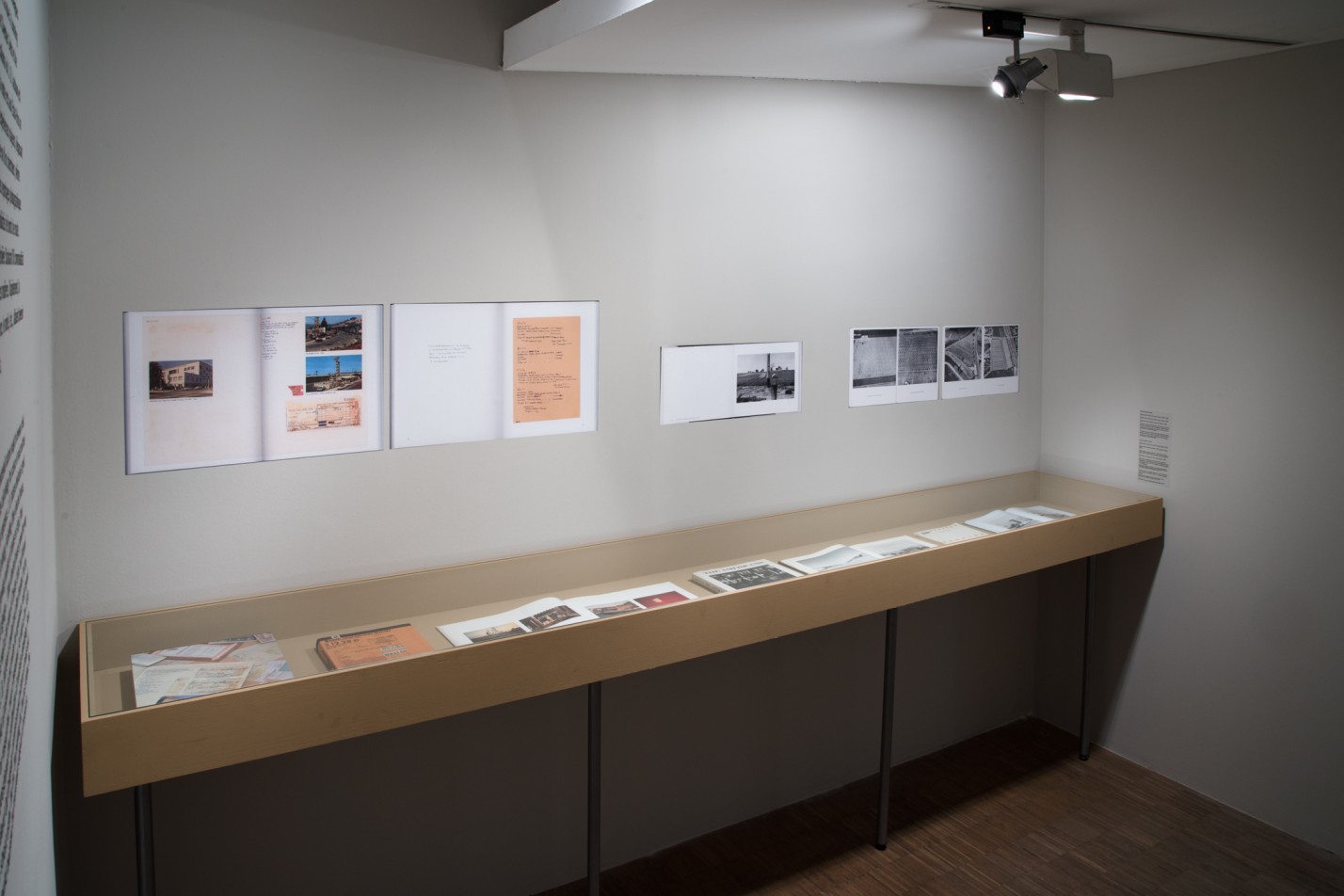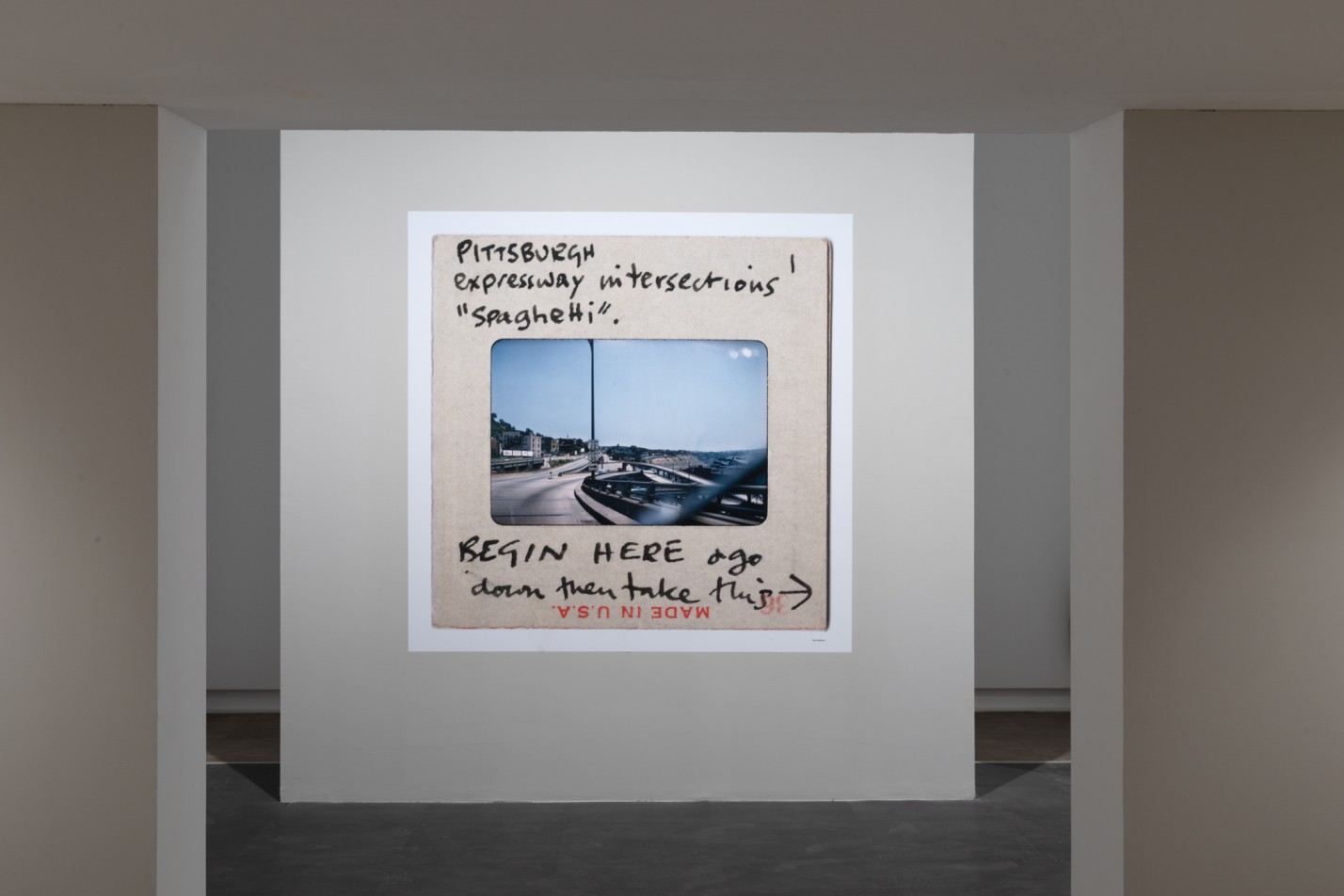Camille Fallet
Notes sur l'asphalte
Une Amérique mobile et précaire 1950-1990
D'innombrables travaux photographiques ont été réalisés sur les paysages américains. A l'écart des étendues sauvages, des monuments naturels et des édifices emblématiques, la géographie ordinaire, celle qui est pratiquée au quotidien, n'a pas été écartée. Des bicoques en bois des années 1930 aux lotissements contemporains, des bourgs pionniers aux shopping centers, l'Amérique paraît avoir été photographiée en tout point.
Notes sur l'asphalte entend contribuer à ce vaste ensemble photographique, tout en faisant un pas de côté. Cette exposition est composée de travaux n'ayant quasiment jamais été montrés en dehors de cercles universitaires restreints. Y sont présentés les documents photographiques que des chercheurs ont produits, alors qu'ils partaient s'enquérir de l'architecture et des paysages américains, dans ce qu'ils ont de plus communs. Des années 1950 à 1990, des géographes, historiens du paysage, architectes et urbanistes sont en effet partis sur les routes, à travers une agglomération, un État, l'ensemble du pays, circulant parfois sans destination précise. Leur objectif était de mieux connaître les lieux que les Américains habitent et façonnent, mais aussi de mettre en place des manières d'enquêter basées sur la photographie. Ces chercheurs ont prélevé, collecté, emporté, archivé des fragments de réalité, pour ensuite s'y référer dans leurs écrits.
Parmi ces chercheurs, six sont exposés : John Brinckerhoff Jackson, figure fondatrice des landscape studies, David Lowenthal, théoricien du paysage et du patrimoine, Donald Appleyard et Allan Jacobs, architectes et urbanistes, Chester Liebs et Richard Longstreth, américanistes et historiens du bâti. Leurs archives sont composées de milliers de prises de vue, pour certains, de dizaines de milliers, pour d'autres. À l'exception notable des pellicules noir et blanc de D. Lowenthal, toutes leurs photographies ont été réalisées sur diapositives. J. B. Jackson et A. Jacobs ont utilisé la couleur dès les années 1950, D. Appleyard, R. Longstreth et C. Liebs, à partir des années 1960 et 1970, alors même que le noir et blanc était largement dominant dans la photographie documentaire. Ils ont également choisi d'utiliser un appareillage léger, afin que la prise de vue ne les détourne pas de l'expérience directe du terrain. Sans trépied, appareil à la main, à bord d'un véhicule ou non loin, ils étaient en mesure de prendre des notes visuelles. Enfin, tous se sont tournés vers des paysages fragiles, mouvants et inconstants qui, selon les mots de J. B. Jackson, relèvent du vernaculaire. En un sens, J. B. Jackson, C. Liebs, R. Longstreth, etc., ont fait preuve d'une curiosité continue pour une géographie qui, a priori, n'avait rien de remarquable et était susceptible de s'effacer rapidement.
Bien qu'elles relèvent de démarches de recherche longuement développées, leurs notes photographiques n'ont pas été basées sur des protocoles strictement définis. Elles sont issues de pratiques amateurs, empiriques et personnelles, et ne résultent pas de savoir-faire professionnels, bien qu'elles aient été effectuées à des fins scientifiques.
Les archives de six chercheurs
Les travaux photographiques de J. B. Jackson, D. Lowenthal, D. Appleyard, A. Jacobs, C. Liebs et R. Longstreth ont en grande partie échappé à l'histoire de la photographie et à ceux qui l'écrivent, et ce, pour plusieurs raisons : leurs auteurs n'appartiennent pas au monde de l'art, ils n'avaient pas été reconnus comme des acteurs de la photographie documentaire, ils n'ont pas participé à des commandes photographiques institutionnelles, enfin, ils n'ont pas valorisé leurs photographies comme des œuvres à part entière. Un des moyens de localiser leurs prises de vue est d'identifier des ouvrages structurés autour d'observations visuelles accompagnées de prises de vue personnelles. Il est ainsi possible de remonter des livres aux archives, lesquelles sont conservées dans des centres de recherche, au bureau ou au domicile des auteurs. Les photographies y sont classées comme des notes de terrain factuelles. Regroupées par catégorie, elles donnent à voir des paysages composés de silos, de stations-service, de mobile homes, de main streets, de même que des festivités et des rassemblements plus ou moins informels...
Afin de rendre compte de l'organisation de ces archives, des grilles thématiques ont été constituées. Elles comportent des photographies de plusieurs auteurs et reprennent certains de leurs sujets de prédilection. Parallèlement, des diapositives ont été entièrement reproduites, dans le but de restituer leur richesse graphique : la prise de vue est encadrée par une monture sur laquelle les auteurs ont renseigné les lieux, les sujets et les scènes photographiés. Enfin, un diaporama synthétisant les travaux de D. Lowenthal vient compléter cette première étape consacrée aux archives des six chercheurs de Notes sur l'asphalte.
Un voyage au sein d'une Amérique mobile et précaire
Au regard de ses diapositives, J. B. Jackson a voyagé de 1956 à 1989, année après année, en moto, en voiture. Il a alterné des parcours d'un ou de quelques jours et des périples longs et sinueux. En tout sens, il a cheminé à travers les États-Unis, comme en mai 1976, lorsqu'il avait fait étape en Californie, au Nouveau-Mexique, dans l'Oklahoma, etc., jusqu'à bifurquer vers l'Illinois, l'Indiana et l'Iowa. La régularité et la durée de ses périples font de lui un chercheur-voyageur singulier, mais durant la même période, il ne fut pas le seul à s'enquérir sur la route de l'originalité, du devenir et des fragilités du paysage américain. Suite à l'obtention en 1965 d'une bourse Guggenheim, D. Lowenthal a voyagé et photographié durant trois ans, notamment du Vermont à la Pennsylvanie et de la frontière mexicaine à la Colombie britannique, au Canada. À partir de la fin des années soixante, R. Longstreth est parti à la découverte de l'architecture commerciale le long des main streets, des strips et d'une multitude de bords de routes. C. Liebs a fait de même au tournant des années 1970 et 1980 ; il perpétue depuis ses pratiques à la fois routières et photographiques. Si A. Jacobs et D. Appleyard ont surtout investi des métropoles, dont celles de San Francisco, Pittsburgh et San Diego-Tijuana, c'est en se déplaçant d'un axe à l'autre et en s'interrogeant sur les circulations urbaines qu'ils ont principalement photographié.
Les archives de Notes sur l'asphalte permettent ainsi de façonner un voyage synthétique, au cours duquel les routes américaines sont jalonnées d'enseignes et de panneaux faits main, d'activités commerciales spontanées et passagères, de constructions répétitives mais diversement utilisées, d'habitats peu ancrés et prêts à être délaissés, de zones reléguées, ou encore de lieux de dépôt et de points de rejets.
Des pratiques photographiques partagées
La photographie des chercheurs et celle des artistes sont unies par certaines convergences, encore peu étudiées. W. Evans, J. B. Jackson, D. Lowenthal et W. Christenberry ont eu un intérêt commun pour la modestie et l'instabilité de l’architecture vernaculaire américaine : de la bicoque en bois des métayers jusqu'au mobile homes du prolétariat contemporain. C. Liebs, R. Longstreth, J. B. Jackson et D. Lowenthal ont lié photographie et périple, comme l'ont fait W. Evans allant vers le Vieux Sud, nombre de photographes de la F.S.A et de la Standard Oil, puis Robert Frank et Stephen Shore... Ils ont privilégié la note photographique, sa spontanéité, sa rapidité et sa capacité d'articulation à l'écrit, comme Dan Graham avec « Homes for America » et Robert Smithson avec « The Monument of Passaic ». Dans « The View from The Road », D. Appleyard s'est posé des questions analogues à celles de J. Wall dans son « Landscape Manual ». Comment appréhender l'environnement extérieur à partir de l'habitacle automobile ? Comment le photographier tout en rendant compte de l'expérience du déplacement ? Les calendriers de Thomas Strong, graphiste à New Haven et ancien élève de W. Evans, conduisent d'ailleurs à se demander si la photographie américaine des paysages ordinaires était vraiment limitée à quelques figures isolées.
Variétés d'auteurs, photographes amateurs, sont manifestement partis photographier le paysage américain, mobile et précaire. Leurs travaux permettent d'envisager une histoire de la photographie bien plus vaste et complexe que ne le laissent apparaître les seules œuvres artistiques pensées et conçues pour être montrées.
Countless photographic works have been produced on the American landscape. Aside from the wilderness, the natural monuments and the iconic buildings, the ordinary, everyday geography has not been ignored. From the wooden shacks of the 1930s to contemporary housing estates, from pioneer towns to shopping centres, America seems to have been photographed from every angle.
Notes sur l’asphalte aims to contribute to this vast body of photographic work, while at the same time taking a step to the side. This exhibition is made up of works that have hardly ever been shown outside restricted academic circles. It presents the photographic documents produced by researchers as they set out to investigate the most common aspects of American architecture and landscapes. From the 1950s to the 1990s, geographers, landscape historians, architects and urban planners took to the roads, travelling through a city, a state or the whole country, sometimes with no specific destination in mind. Their aim was to find out more about the places that Americans inhabit and shape, but also to set up ways of investigating based on photography. These researchers picked up, collected, carried away and archived fragments of reality, and then referred to them in their writings.
Six of these researchers are on display: John Brinckerhoff Jackson, a founding figure of landscape studies; David Lowenthal, a landscape and heritage theorist; Donald Appleyard and Allan Jacobs, architects and urban planners; and Chester Liebs and Richard Longstreth, Americanists and historians of the built environment. Their archives are made up of thousands of shots, for some, and tens of thousands for others. With the notable exception of D. Lowenthal’s black and white film, all their photographs were taken on slides. J. B. Jackson and A. Jacobs began using colour in the 1950s, while D. Appleyard, R. Longstreth and C. Liebs, from the 1960s and 1970s, even though black and white was largely dominant in documentary photography. They also chose to use lightweight equipment, so that shooting did not distract them from direct experience of the field. Without a tripod, camera in hand, in or near a vehicle, they were able to take visual notes. Finally, they all turned to fragile, shifting and inconstant landscapes which, in the words of J. B. Jackson, are vernacular. In a sense, J. B. Jackson, C. Liebs, R. Longstreth, etc. demonstrated a continuing curiosity about a geography that, on the face of it, was unremarkable and likely to fade quickly.
Although they are the result of long-developed research approaches, their photographic notes have not been based on strictly defined protocols. They are the product of amateur, empirical and personal practices, and are not the result of professional know-how, although they were taken for scientific purposes. The photographic works of J. B. Jackson, D. Lowenthal, D. Appleyard, A. Jacobs, C. Liebs and R. Longstreth have largely escaped the notice of photographic history and its writers, for several reasons: their authors do not belong to the art world, they were not recognised as players in documentary photography, they did not participate in institutional photographic commissions, and finally, they did not value their photographs as works in their own right. One way of locating their photographs is to identify works structured around visual observations accompanied by personal shots. In this way, it is possible to trace the books back to the archives, which are kept in research centres, in the offices or homes of the authors. The photographs are classified as factual field notes. Grouped by category, they show landscapes made up of silos, service stations, mobile homes and main streets, as well as festivities and more or less informal gatherings...
Thematic grids have been created to illustrate the organisation of these archives. These include photographs by a number of different photographers and cover some of their favourite subjects. At the same time, the slides have been reproduced in their entirety, with the aim of restoring their graphic richness: the shot is framed by a mount on which the authors have indicated the places, subjects and scenes photographed. Finally, a slide show summarising the work of D. Lowenthal completes this first stage devoted to the archives of the six Notes sur l’asphalte researchers. A journey through a mobile and precarious America
As you can see from his slides, J. B. Jackson travelled from 1956 to 1989, year after year, by motorbike and by car. He alternated between journeys of one or a few days and long, winding journeys. In every direction, he travelled across the United States, as in May 1976, when he stopped off in California, New Mexico, Oklahoma, etc., before branching off to Illinois, Indiana and Iowa. The regularity and duration of his travels make him a singular researcher-traveller, but during the same period he was not the only one to enquire on the road about the originality, the future and the fragility of the American landscape. After receiving a Guggenheim Fellowship in 1965, Lowenthal travelled and photographed for three years, notably from Vermont to Pennsylvania and from the Mexican border to British Columbia, Canada.From the late 1960s onwards, R. Longstreth set out to discover the commercial architecture along main streets, strips and a multitude of roadsides. C. Liebs did the same at the turn of the 1970s and 1980s, and has continued his roadside and photographic practices ever since. While A. Jacobs and D. Appleyard have mainly focused on metropolises, including San Francisco, Pittsburgh and San Diego-Tijuana, it is by moving from one axis to another and questioning urban traffic that they have mainly photographed.
The archives in Notes on Asphalt help to shape a synthetic journey, in which American roads are dotted with handmade signs and billboards, spontaneous and passing commercial activities, repetitive but variously used constructions, loosely anchored habitats ready to be abandoned, relegated areas, and dumping grounds and dumping points. Shared photographic practices
There are certain convergences between the photography of researchers and that of artists that have yet to be fully explored. W. Evans, J. B. Jackson, D. Lowenthal and W. Christenberry have shared an interest in the modesty and instability of American vernacular architecture: from the wooden shacks of sharecroppers to the mobile homes of the contemporary proletariat. C. Liebs, R. Longstreth, J. B. Jackson and D. Lowenthal linked photography and travel, as did W. Evans on his way to the Old South, a number of photographers from the F.S.A and Standard Oil, then Robert Frank and Stephen Shore... They favoured the photographic note, its spontaneity, speed and ability to articulate with the written word, as did Dan Graham with «Homes for America» and Robert Smithson with «The Monument of Passaic». In ‘The View from The Road’, D. Appleyard asked himself questions similar to those asked by J. Wall in his ‘Landscape Manual’. How can the exterior environment be apprehended from inside the car? How do you photograph it while still capturing the experience of travelling? The calendars of Thomas Strong, a graphic artist based in New Haven and a former student of W. Evans, lead us to wonder whether American photography of ordinary landscapes was really limited to a few isolated figures.
A variety of amateur photographers have clearly set out to photograph the mobile and precarious American landscape. Their work makes it possible to envisage a history of photography that is far more vast and complex than the artistic works conceived and designed for display alone would suggest.
